How to Choose Unlimited Residential Proxies for Your Needs
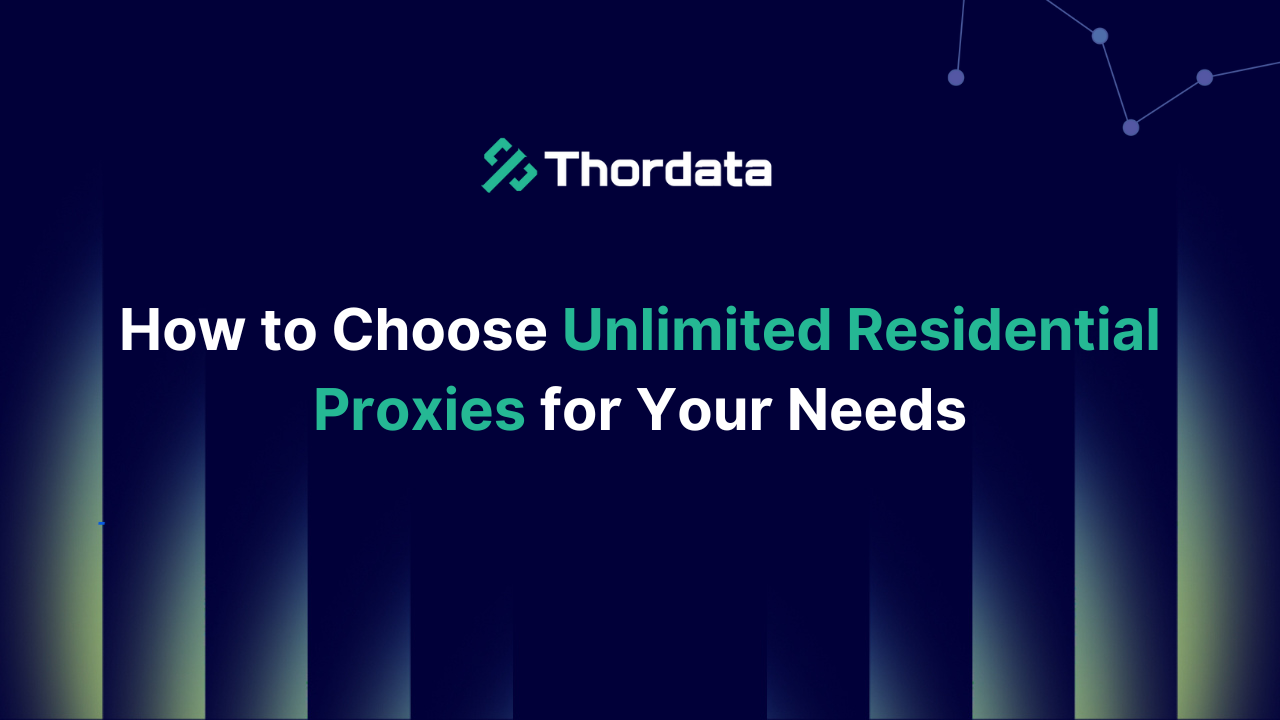

In today’s digital world, online privacy, security, and unrestricted access are more important than ever. Whether you’re involved in web scraping, browsing anonymously, or managing multiple social media accounts, unlimited residential proxies play a pivotal role in keeping your online activities safe, efficient, and undetected. But how do you choose the best unlimited residential proxies for your needs? In this guide, we’ll explore everything you need to know, from the basics of residential proxies to how to select the right provider.
What Makes Unlimited Residential Proxies Different?
Residential proxies are IP addresses provided by Internet Service Providers (ISPs) to homeowners. These IP addresses are associated with real devices and are highly sought after for tasks like web scraping, SEO monitoring, and social media management. They are distinct from datacenter proxies, which come from data centers rather than real users and can easily be flagged as non-human traffic by websites.
Unlike datacenter proxies, residential proxies allow you to appear as a regular user accessing a website, making them less likely to be blocked or flagged. With unlimited residential proxies, you can access a pool of diverse, rotating IP addresses, improving your ability to avoid restrictions and stay anonymous online.
1. Bypass Geo-Restrictions: Residential proxies are often used to access region-locked content. Whether it’s a website only available in a certain country or streaming services that block content based on location, unlimited residential proxies give you the power to appear as though you’re browsing from any location in the world.
2. Enhanced Privacy and Anonymity: Since residential proxies use real IPs, they offer a high level of anonymity, making them ideal for sensitive tasks like web scraping, social media management, or SEO monitoring. With unlimited bandwidth, you can scrape large volumes of data without the fear of being detected.
3. Reduced Risk of IP Bans: Many websites detect multiple requests from the same IP address and block those users. By rotating between a large pool of residential IPs, unlimited residential proxies reduce the risk of IP bans, keeping your activities seamless and uninterrupted.
4. Scalability: If your needs grow, unlimited residential proxies can scale with you. With providers offering a large number of rotating IPs, you can handle large volumes of requests without worrying about running out of resources.
Key Factors to Consider When Choosing Unlimited Residential Proxies
Choosing the right residential proxy provider is crucial to ensure optimal performance and security. Below are some key factors to keep in mind when selecting unlimited residential proxies for your needs:
1. IP Pool Size and Variety
The bigger the pool of IPs, the better the rotation and anonymity. Some providers have limited pools, meaning your IPs may be exhausted quickly, leading to potential issues with bans and CAPTCHAs. Make sure the provider you choose offers a large pool of residential IPs across a variety of geolocations to ensure maximum flexibility for your use case.
2. Speed and Reliability
Proxy speed is critical, especially for tasks like web scraping and SEO monitoring, where speed directly impacts efficiency. A reliable proxy provider will ensure fast response times, minimal downtime, and a stable connection. Always check for latency and ensure your provider offers adequate bandwidth to handle heavy usage.
3. Security Features
When dealing with sensitive data or confidential activities, security is paramount. Look for providers that offer encryption, secure connections, and anti-fraud mechanisms. Thordata, for instance, is known for its robust security, ensuring that all data transmitted through their proxies is encrypted.
4. Customer Support
Good customer support is a must for any proxy service. You may run into technical issues or need advice on how to integrate proxies into your workflows. Make sure the provider offers 24/7 support through live chat, email, or phone support to assist you whenever needed.
5. Pricing Plans
While unlimited residential proxies offer many advantages, their pricing can vary widely. Some providers charge per GB of data usage, while others have fixed monthly fees. Be sure to assess your usage needs and choose a provider that offers the best value for money. Many services, including Thordata, offer flexible plans tailored to different user needs.
Use Case Match: Does It Fit What You Need?
|
Use Case
|
Key Needs
|
Red Flags
|
|
Web Scraping
|
Large IP pool, high uptime, HTTP/HTTPS support
|
Small pool (risk blocks), slow response
|
|
Ad Verification
|
Geographic diversity, low latency
|
Limited country coverage, inconsistent IPs
|
|
Social Media Management
|
Clean IPs (not blacklisted), easy device setup
|
IPs flagged as “bot” by platforms like Instagram
|
|
Gaming/Streaming
|
Low-latency, reliable connection
|
High ping, frequent disconnections
|
Comparison Table
| Feature | Thordata | Bright Data | DOCODO | Oxylabs |
| IP Pool Size | 60 million+ | 72 million+ | 40 million+ | 100 million+ |
| Geolocation | Global | Global | 195+ countries | Global |
| Speed | High | High | Moderate | High |
| Security | Strong encryption | Good | Good | Strong encryption |
| Support | 24/7 | 24/7 | Business hours | 24/7 |
| Pricing | Flexible & Affordable | Premium | Affordable |
Premium |
Why Thordata Stands Out in 2025
1. True Unlimited Plan: No hidden caps on data or connections—perfect for large-scale scraping or running 100+ bots simultaneously.
2. Global Reach: Whether you need IPs in Thailand for SEO monitoring or Argentina for gaming, their 195-country coverage has you covered.
3. Security First: Zero-logging policy and end-to-end encryption mean your activities stay private, critical for businesses handling sensitive data.
4. User-Friendly Setup: Their dashboard lets you filter IPs by country, ISP, or device type with a few clicks—no coding required.
Frequently asked questions
What are residential proxies, and how do they work?
Residential proxies use IP addresses assigned to real users by ISPs, providing you with a high level of anonymity and allowing you to bypass restrictions and scrape data without being detected.
How do I choose the best unlimited residential proxies?
Look for a provider with a large IP pool, high-speed performance, strong security features, 24/7 support, and flexible pricing plans to ensure they meet your needs.
Can I use Thordata’s proxies for large-scale web scraping?
Yes, Thordata offers a vast pool of residential IPs with automatic rotation, making it ideal for large-scale scraping projects.
About the author
Jenny is a Content Manager with a deep passion for digital technology and its impact on business growth. She has an eye for detail and a knack for creatively crafting insightful, results-focused content that educates and inspires. Her expertise lies in helping businesses and individuals navigate the ever-changing digital landscape.
The Thordata Blog offers all its content in its original form and solely for informational intent. We do not offer any guarantees regarding the information found on the Thordata Blog or any external sites that it may direct you to. It is essential that you seek legal counsel and thoroughly examine the specific terms of service of any website before engaging in any scraping endeavors, or obtain a scraping permit if required.
Beginner Guide to ISP vs Residential Proxies
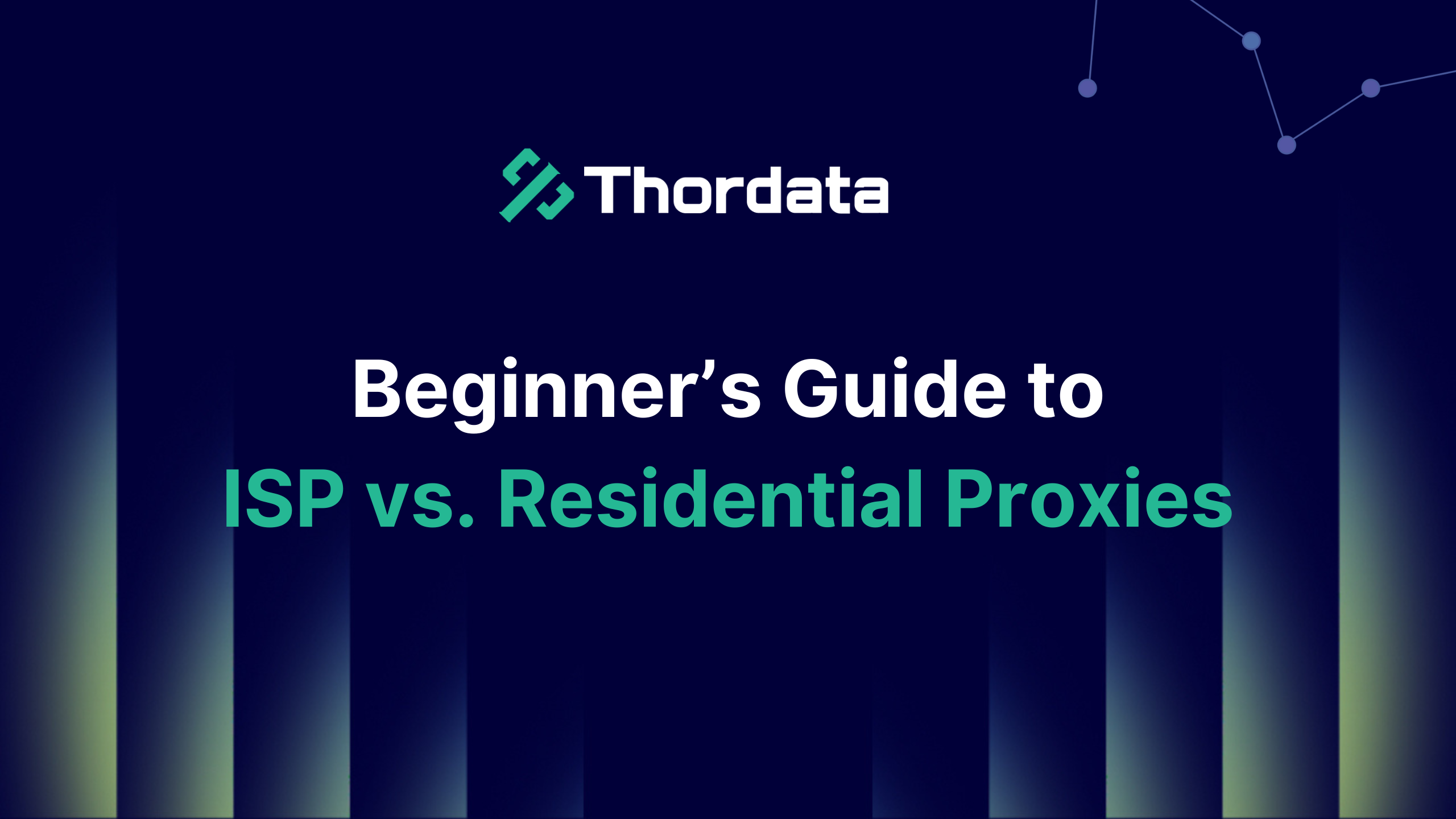

Choosing between ISP and residential proxies is crucial for your proxy setup. Both types hide your online identity but work differently regarding speed, stability, and detection rates.
This piece will get into the key differences between these proxy types. You’ll learn their strengths and weaknesses to help you pick the right solution. Whether you need proxies to scrape web data, track SEO, or run multiple online accounts, you’ll find the answers here.
What are ISP proxies?
ISP proxies (also called static residential proxies) blend datacenter infrastructure with legitimate Internet Service Provider registration. They’re IP addresses registered with genuine Internet Service Providers but hosted on datacenter servers instead of end-user devices. This unique mix gives them datacenter proxies’ speed and stability plus residential IPs’ legitimacy. Ideal for tasks that require a consistent identity and long-lived sessions.
What is a residential proxy?
A residential proxy works as a middle server that routes internet traffic through IP addresses. Internet Service Providers (ISPs) assign these IPs to real households. These IPs belong to actual residential devices—computers, smartphones, tablets, and other home equipment connected to Wi-Fi networks. They show a real physical location, which makes them valuable to access sensitive websites with strict security protocols.
Your request goes through the proxy server when you connect through a residential proxy. The server then forwards it to the target website using one of its residential IPs. The website sees this traffic as coming from a regular home user instead of a proxy service. So your real location and identity stay hidden while your browsing activity looks legitimate.
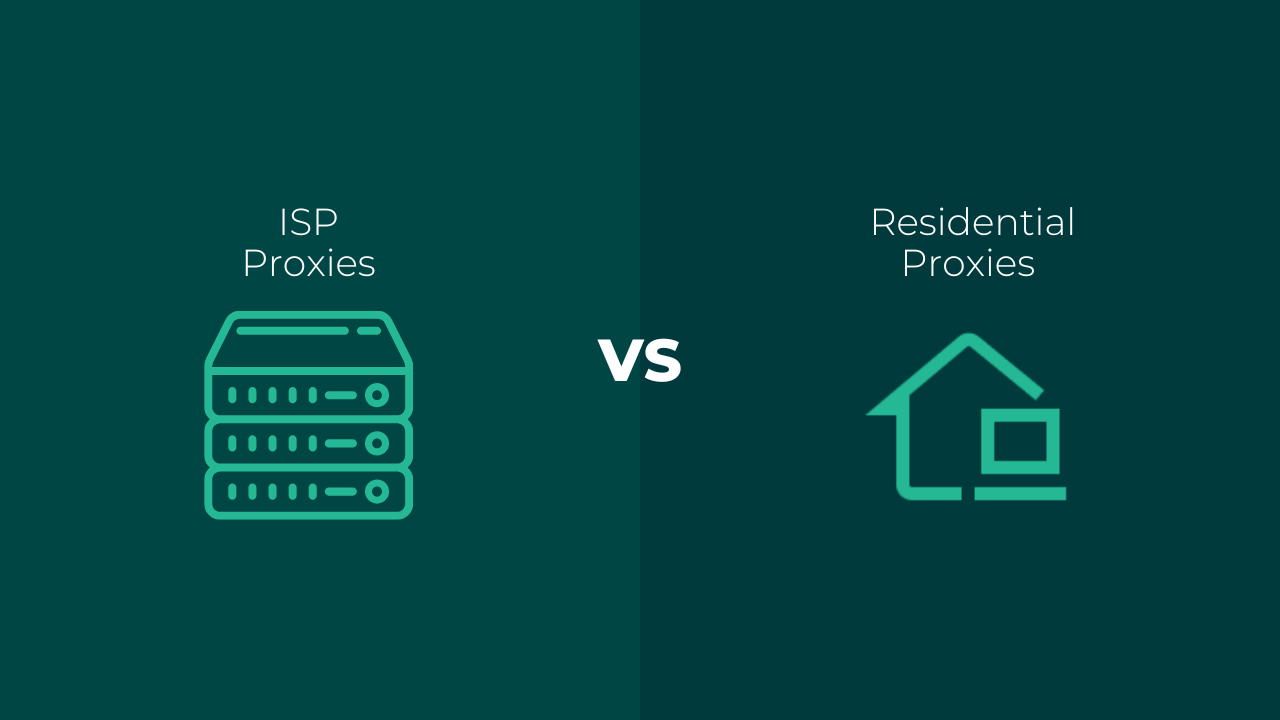
Comparing strengths and weaknesses
A good look at ISP and residential proxies shows they each have their own strengths and weaknesses. Let’s take a closer look at what makes each type special and where they might not work so well.
ISP proxies: Pros and cons
ISP proxies blend datacenter infrastructure with legitimate IP registration. This creates a strong hybrid solution with clear benefits.
Advantages:
Superior speed and performance – These proxies work fast and stay up longer because they run on datacenter infrastructure with high-bandwidth connections
Extended session stability – Unlike their residential counterparts, ISP proxies keep connections going without breaks, which works great when you need steady connections
Reduced blocking risk – Websites see these as normal traffic, so they get blocked less often than regular datacenter options
Immediate availability – You can get lots of IPs right away and control how your sessions work
Disadvantages:
Higher cost – You’ll pay more for ISP proxies than datacenter options because they’re more reliable and legitimate
Limited subnet diversity – The IPs usually come from specific ranges, so if one gets blocked, others might too
Narrower geographic coverage – You won’t find as many location options as you would with residential proxy networks
Residential proxies: Pros and cons
These proxies use real household IP addresses to create a genuine online presence.
Advantages:
Enhanced anonymity – Your traffic goes through actual residential devices, making these proxies very hard to spot
Excellent IP diversity – The IPs rarely share subnets, so blocks don’t spread between addresses
Advanced geo-targeting – With IPs from real homes worldwide, these proxies work great at getting past geo-restrictions
Reduced detection risk – Even the best anti-bot systems don’t deal very well with residential proxies
Disadvantages:
Variable speeds – Since they use real people’s connections, these proxies can be slower and less steady
Potential instability – You might see some disconnects when devices go offline or have network problems
Premium pricing – Good residential proxy networks cost more because they’re authentic and reach globally
Which is more reliable?
Your specific needs determine reliability. ISP proxies work better when you need steady, long-term connections with stable performance. They have minimal downtime and consistent speed, which helps with data-heavy tasks like SEO monitoring or managing accounts.
Residential proxies shine when staying hidden matters most. They look just like regular users, so they can access even the most protected websites.
To cite an instance, ISP proxies work great for price tracking and market research where speed counts most. Residential proxies do better with ad checking and accessing region-locked content where looking like a local user matters more than pure speed.
The best choice depends on what you need most – whether that’s staying anonymous, speed, stability, or keeping costs down. Each type has its sweet spot, and knowing these differences helps you pick the right tool for your job.
Use cases
E-commerce
E-commerce companies use proxies to keep track of prices and analyze their competition. ISP proxies work best here because they’re fast and reliable for collecting large amounts of data. These companies use proxies to check their competitors’ prices and product availability without getting caught.
Check search results from different locations to track keyword rankings
Get unbiased results without personal search history affecting them
Look at backlinks and what competitors do without raising red flags
Ad verification
Digital advertisers need to verify their ads more than ever. Ad verification companies play a constant game of catch-up with fraudsters. They visit ad placements and suspicious sites to catch bad actors. These companies need residential proxies to:
See content and ads that are limited to specific regions
Make sure ads show up where they should
Check if ads reach the right people in the right places
Account management
Security systems often block companies trying to create multiple social media or e-commerce accounts from one IP address. Residential proxies help solve this problem by providing different IP addresses that look like separate users.
ISP vs. residential proxies comparison
| Feature | ISP Proxy | Residential Proxy |
| Source | Data-center networks | Real residential IPs |
| Speed | High | Medium |
| Bandwidth | High, often unlimited | Variable |
| Reliability | High uptime | Low-Medium |
| Anonymity | Medium | High |
| Detection & Block Risk | Higher; sites often block data-center ranges | Lower; harder to distinguish from genuine users |
| Cost | Usually more expensive | Usually cheaper |
| Geographic Coverage | Good coverage in major regions | Good coverage in major regions |
| Rotation Capability | Supports automatic IP rotation | Usually requires manual rotation |
Conclusion
ISP proxies excel with their perfect mix of speed and legitimacy. They deliver datacenter-level performance while looking like regular user traffic, which makes them perfect for tasks that need stable, long-term connections. Residential proxies shine when you need maximum anonymity, especially when you have highly secured websites that use sophisticated detection systems.
Websites keep implementing more sophisticated detection methods, which reshapes the scene of proxy services constantly. Staying up to date with the technical differences between these proxy types helps you make smarter choices for your specific needs. Whether you pick ISP or residential proxies, knowing their strengths, limits, and best uses will help you implement the right solution that works for you.
Frequently asked questions
What’s the Difference Between ISP and Residential Proxies?
The main difference between ISP and residential proxies lies in their infrastructure and usage. ISP proxies use IP addresses assigned by internet service providers, offering high speed and stability. Residential proxies, on the other hand, use IPs from real users’ home networks, making them more authentic and harder to detect.
Are residential proxies cheaper than ISP proxies?
Generally speaking, residential proxies are cheaper than ISP proxies. ISP proxies are usually more expensive due to their high speed and stability. Residential proxies are usually cheaper, but may require a larger proxy pool to compensate for potential slowdowns and IP rotation needs.
How to choose between residential proxy and ISP proxy?
Choose based on your needs: use residential proxies for higher anonymity and geo-targeting, and ISP proxies for faster, more stable performance in tasks like Account Management.
About the author
Yulia is a dynamic content manager with extensive experience in social media, project management, and SEO content marketing. She is passionate about exploring new trends in technology and cybersecurity, especially in data privacy and encryption. In her free time, she enjoys relaxing with yoga and trying new dishes.
The thordata Blog offers all its content in its original form and solely for informational intent. We do not offer any guarantees regarding the information found on the thordata Blog or any external sites that it may direct you to. It is essential that you seek legal counsel and thoroughly examine the specific terms of service of any website before engaging in any scraping endeavors, or obtain a scraping permit if required.
How to Find and Configure Your Proxy Server Address
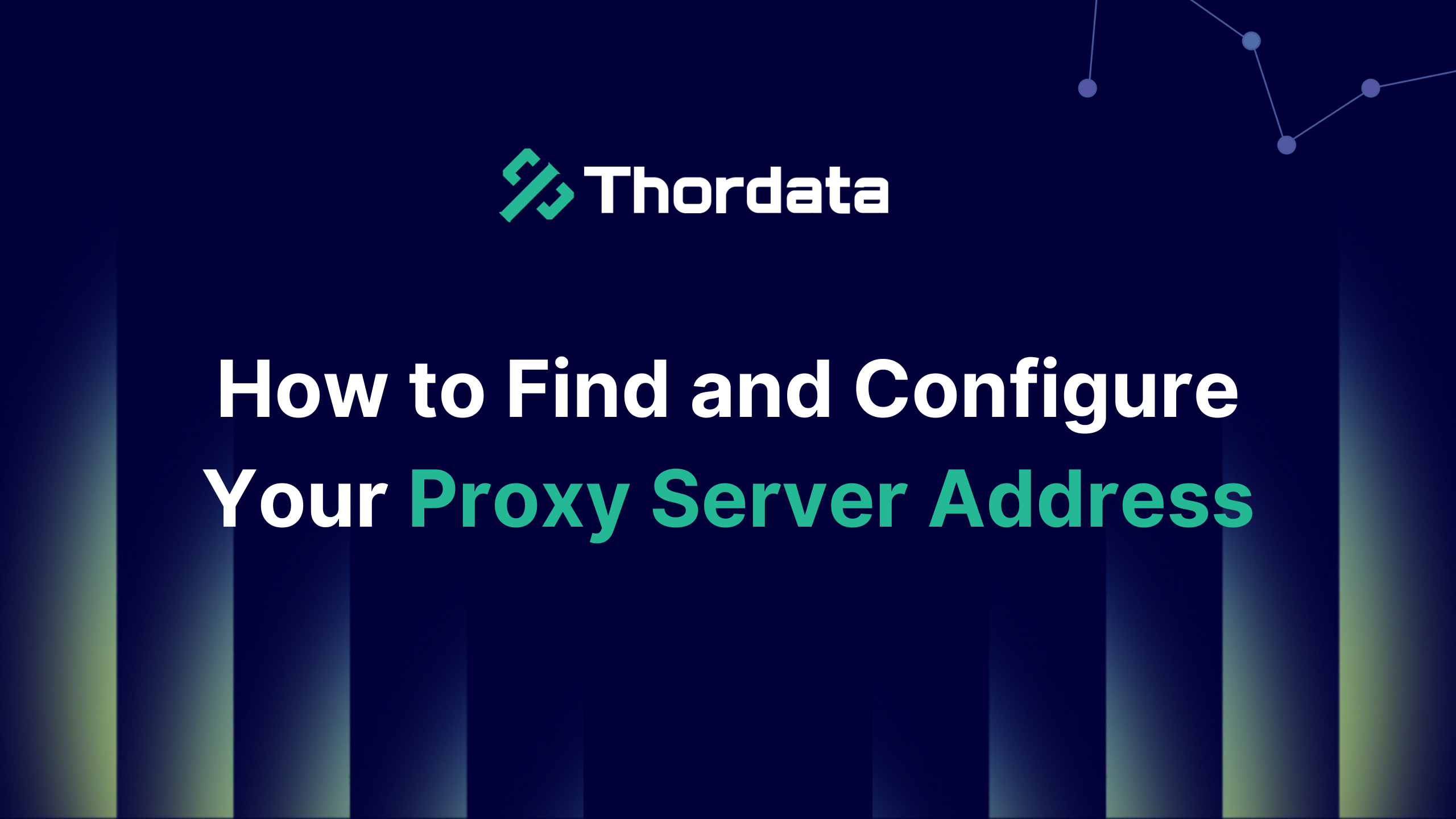

Proxy server addresses are vital intermediaries that stand between your device and the internet to boost your privacy by masking your IP address. These digital gatekeepers shield your online activity and help you stay anonymous while browsing. Your internet traffic flows through an extra server that hides your actual location and identity from the websites you visit.
Let’s explore everything about proxy server addresses in this piece. You’ll learn how they work, why you need them, and the best ways to find these settings on devices and browsers of all types.
What is a Proxy Server Address?
A proxy server address is a vital identifier that routes your internet traffic through an intermediary server before reaching its destination. Your device connects to websites through this address instead of making direct connections.
How proxy servers work
Proxy servers catch requests between your device and the internet. Here’s how the process works:
1. Your device sends a web request to the proxy server instead of directly to the website
2. The proxy server uses its own IP address to forward this request to the target website
3. The website processes the request and sends information back to the proxy server
4. The proxy checks the returned data for any threats
5. The proxy sends the filtered content to your device
This positioning between you and the internet lets proxy servers perform multiple functions. They filter content, encrypt data for security, hide your original IP address, and cache popular webpages to speed up browsing. The proxy server’s security layer stops cyber attackers from accessing your network directly.
What does a proxy address look like?
Proxy server addresses show up in specific formats based on the protocol and addressing system. Common formats include
IPv4 format: Four number groups from 0-255 separated by dots (e.g., 192.168.1.1)
IPv6 format: Eight groups of four hexadecimal numbers separated by colons (e.g., 2001:0db8:85a3:0000:0000:8a2e:0370:7334)
Why You Might Need to Find Your Proxy Address
Your proxy server address plays a vital role in today’s complex networking environments. Learning when and why you need these settings can save you time and prevent frustration in many situations.
Network setup and configuration
Proxy servers are essential components that network administrators use to filter and monitor web traffic from employee computers. You’ll need to input the correct proxy server address to get internet access when you set up a new device or join a company network.
Troubleshooting internet issues
Proxy settings often cause internet connectivity problems. Users can’t access the internet when they see the error message “Network can’t find proxy server.” These issues often clear up by checking and sometimes disabling proxy settings.
Apps that won’t connect or websites showing proxy errors need proxy server address verification first. Your internet access can return quickly once you find and fix these proxy errors.
Accessing restricted content
Proxy servers help users bypass geographical restrictions on internet content. A proxy server in another region lets you access:
● Region-specific streaming content is unavailable in your location
● Websites blocked by organizational firewalls or national censorship
● Online services that limit access based on geographical location
● Games and updates were released earlier in other countries
Each proxy type works differently for content access. Residential proxies use IP addresses from actual homes, making them hard to detect and block. These work great for streaming services and content platforms that actively look for and block proxy connections.
Ensuring privacy and security
Privacy protection stands out as the main reason people use proxy servers. Your web requests go through the proxy server’s address and hide your actual IP address. This stops websites from tracking what you do online and collecting personal information.
Proxy servers bring extra security benefits, too. They can encrypt your web requests to protect sensitive information from prying eyes. They also block known malware sites to add more protection while you browse.
How to Find Your Proxy Server Address on Different Devices
The way to find your proxy server address varies substantially based on your operating system. Each system has its own method to view or change network proxy settings. Here’s a simple breakdown of how to do this on common operating systems.
Windows: Using Settings and Internet Options
Windows gives you two main ways to find your proxy server address. The quickest way is through the Settings app:
1. Open the Settings app by pressing Windows key + I
2. Go to Network & Internet
3. Select Proxy from the left sidebar
4. Look under “Manual proxy setup” to see the address and port if a proxy is set up

macOS: Using System Preferences
Mac users can find their proxy server address in network settings:
1. Click the Apple menu in the top-left corner
2. Select System Settings (or System Preferences in older versions)
3. Click on Network
4. Select your active connection (Wi-Fi or Ethernet)
5. Click Details or Advanced
6. Go to the Proxies tab
The Proxies tab shows several options:
Auto Proxy Discovery: Sets up proxy settings automatically
Automatic Proxy Configuration: Uses a proxy auto-configuration (PAC) file
Web Proxy (HTTP): Shows HTTP proxy server address and port
Secure Web Proxy (HTTPS): Shows HTTPS proxy server address and port
SOCKS Proxy: Shows SOCKS proxy server address and port
Linux: Accessing Network Proxy Settings
To find the proxy settings in a Linux system, go to Settings > Network > Network Proxy. This will open a pop-up window where you can select either the automatic or manual option to view and configure the proxy server.
Finding Proxy Settings in Popular Browsers
Google Chrome
Chrome simplifies proxy management by directing users to system-level settings rather than browser-specific options. Here’s how to check your proxy address in Chrome:
1. Click the three dots in the top-right corner and select “Settings.”
2. Scroll down to “System” or search for “proxy” in the settings search bar
3. Click on the “Open your computer’s proxy settings” option
Clicking on that option will take you directly to Windows’ proxy settings. You can also type “chrome://settings/system” into Chrome’s address bar for quick access.
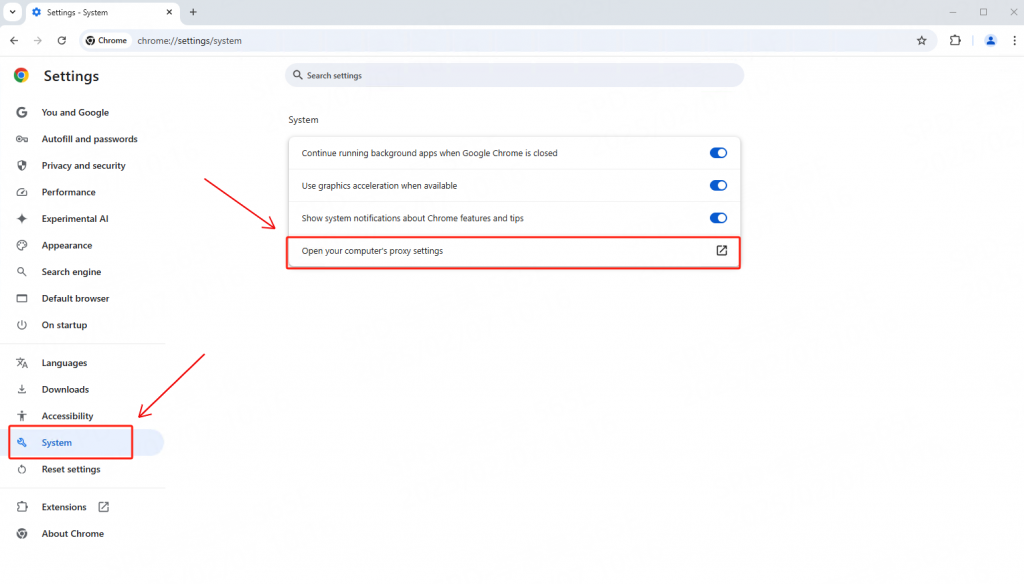
Mozilla Firefox
Firefox sets itself apart by giving you both system-level integration and browser-specific proxy settings. This makes Firefox really useful when you need different proxy settings from your system defaults.
Finding or setting up your proxy server address in Firefox is straightforward:
1. Open Firefox menu (three lines) and select “Settings” or “Options.”
2. Go to “General” and scroll to “Network Settings.”
3. Click “Settings” to open the Connection Settings dialog
Microsoft Edge
Edge works like Chrome and uses system settings for proxy setup. Here’s how to find your proxy address in Edge:
1. Click the three dots in the top-right corner and select “Settings.”
2. Choose “System and performance” from the left sidebar
3. Click “Open your computer’s proxy settings.”
This opens your system’s network settings panel. Power users can also use command-line options to set up custom proxy configurations without changing system-wide settings.
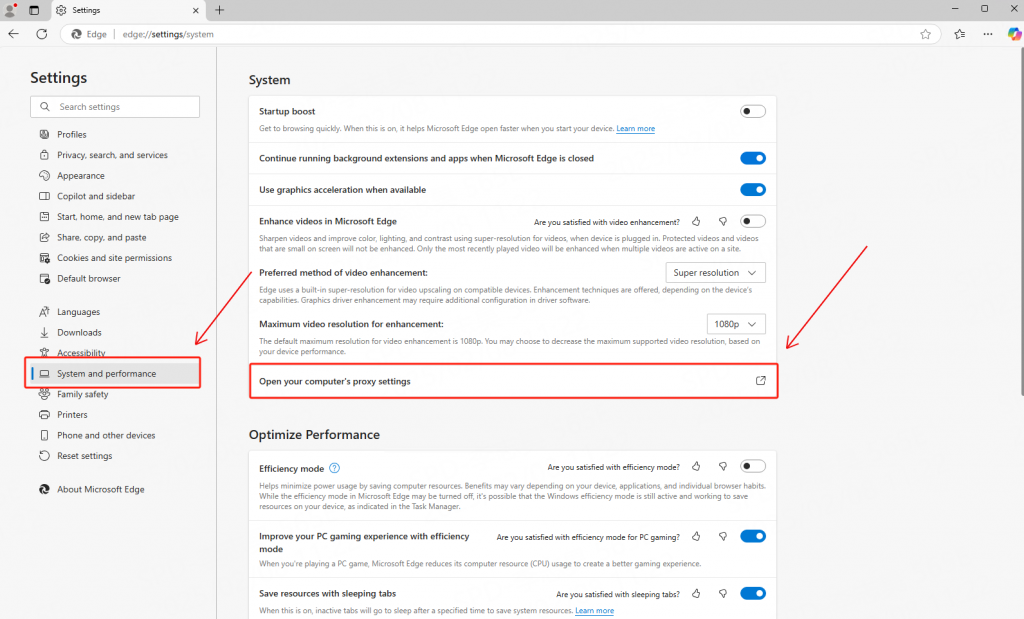
Conclusion
Finding and setting up your proxy server address might look intimidating at first. The various methods in operating systems of all types and browsers will help you feel confident about these settings. Proxy servers are vital intermediaries that mask your IP address and provide better privacy and security.
This piece covered everything about proxy server addresses. The first part helped you learn about these addresses – whether they appear as numeric IPs or user-friendly URLs. On top of that, you discovered why you need to find your proxy settings, from fixing network issues to accessing geo-restricted content.
Thordata is the world’s leading proxy IP and data collection solution service provider. We have the best proxy servers and a wide range of proxy types, including
Residential Proxy -6000W real residential proxies in 195 countries/regions
Static ISP Proxy – Static residential proxy, unlimited traffic, and concurrency
Datacenter Proxy – High-speed, cost-effective static proxy
Unlimited Proxy Servers – Unlimited traffic, unlimited IP number, unlimited concurrency.
Start your free trial with Thordata today to boost your business scalability and productivity!
Frequently asked questions
How do I find my proxy server address?
You can find your proxy server address by checking your network settings—on Windows, go to Settings > Network & Internet > Proxy; on macOS, go to System Settings > Network > Advanced > Proxies.
What is a proxy address for Wi-Fi?
A proxy address for Wi-Fi is the IP address and port number of a proxy server that your device uses to route internet traffic, often to enhance privacy, control access, or bypass restrictions.
Can I get a free proxy server?
Thordata offers a free proxy trial—simply register an account on our website and get in touch with one of our expert account managers to get started.
About the author
Yulia is a dynamic content manager with extensive experience in social media, project management, and SEO content marketing. She is passionate about exploring new trends in technology and cybersecurity, especially in data privacy and encryption. In her free time, she enjoys relaxing with yoga and trying new dishes.
The thordata Blog offers all its content in its original form and solely for informational intent. We do not offer any guarantees regarding the information found on the thordata Blog or any external sites that it may direct you to. It is essential that you seek legal counsel and thoroughly examine the specific terms of service of any website before engaging in any scraping endeavors, or obtain a scraping permit if required.
IPv4 vs IPv6: A Comprehensive Comparison Guide for 2025
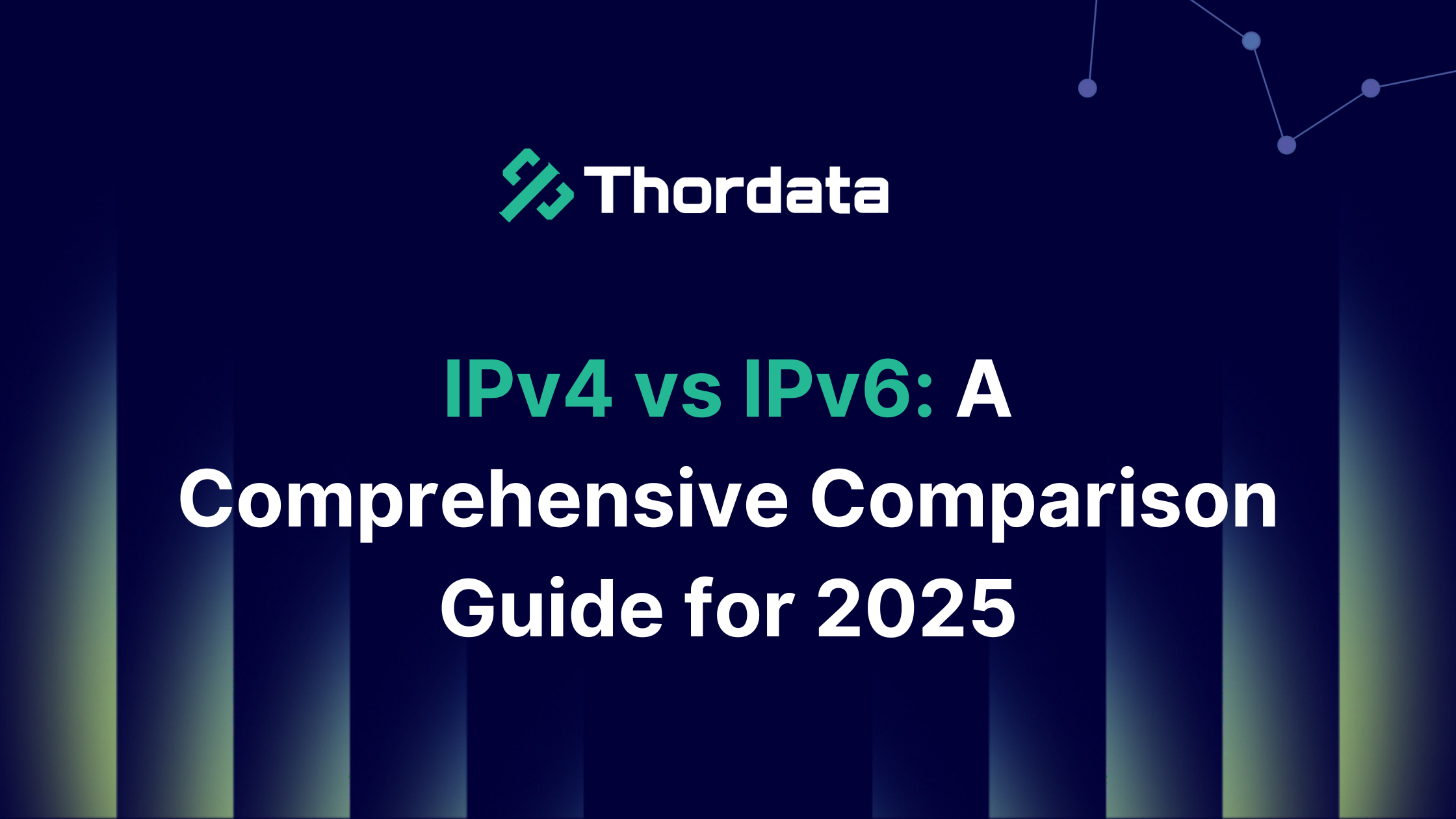

IPv4 vs IPv6 stands as a crucial comparison in 2025, with the older protocol still powering over 90% of internet traffic despite being officially deprecated since 2015. This continued dominance represents a fascinating technological reality when you consider that IPv4’s 32-bit address space allows for only 4.3 billion unique addresses, while IPv6’s 128-bit structure delivers approximately 3.4×10^38 addresses – essentially an unlimited supply for our connected world.
In this guide, you’ll discover the key distinctions between these protocols, understand why transitioning to IPv6 remains both necessary and challenging, and learn what these changes mean for internet connectivity in 2025 and beyond.
Understanding IPv4 and IPv6
The Internet Protocol (IP) system forms the foundation of internet connectivity, enabling billions of devices to communicate worldwide. IPv4 and IPv6 represent different generations of this crucial technology, each with distinct characteristics and capabilities.
What is IPv4?
IPv4 uses a 32-bit address format, providing approximately 4.3 billion unique addresses (2^32). These addresses appear in dot-decimal notation, consisting of four decimal numbers (0-255) separated by periods, like 192.168.1.1.
The IPv4 addressing structure divides addresses into network and host portions. Network bits indicate the logical network area, while host bits specify the logical location within that network. IPv4 addresses fall into five classes (A, B, C, D, and E) determined by the most significant bits of the first byte.
Key limitations of IPv4 include:
● Address exhaustion – The 4.3 billion addresses proved insufficient for modern needs, with unallocated IPv4 addresses becoming exhausted in 2011
● Inefficient routing – Many non-contiguous IPv4 addresses were allocated, making route summarization difficult
● Limited security – The original design lacked built-in security features
● Weak protocol extensibility – The IPv4 header has insufficient size for additional parameters
Address allocation was also geographically imbalanced, with almost 50% of all addresses reserved for the United States.
What is IPv6?
IPv6 employs a 128-bit address structure, delivering an astronomical 340,282,366,920,938,463,463,374,607,431,768,211,456 unique addresses. These addresses appear as eight groups of four hexadecimal digits separated by colons, such as 2001:0db8:0000:0000:0000:8a2e:0370:7334.
For better readability, IPv6 addresses can be shortened by omitting leading zeros in each group (2001:db8:0:0:0:8a2e:370:7334) and further compressed by replacing consecutive zero groups with a double colon (::) used once in an address (2001:db8::8a2e:370:7334).
IPv6 delivers significant improvements over its predecessor:
● Simplified headers with fewer fields (8 vs 12 in IPv4), making processing more efficient
● Built-in security through integrated IPsec at the network layer
● Better Quality of Service (QoS) capabilities for prioritizing time-sensitive traffic
● Stateless address auto-configuration for easier network administration
● Improved routing efficiency without packet fragmentation
Key Differences Between IPv4 and IPv6
The differences between IPv4 and IPv6 go far beyond theoretical distinctions, directly affecting how networks function in everyday scenarios. Let’s examine these key differences in practical terms.
Address length and structure
IPv4 and IPv6 addresses look completely different at first glance. IPv4 uses a 32-bit address structure shown as four decimal numbers (0-255) separated by periods. IPv6, on the other hand, employs a 128-bit format with eight groups of hexadecimal digits separated by colons. This expansion creates a massive increase in available addresses—from approximately 4.3 billion in IPv4 to 340 undecillion (3.4×10^38) unique addresses in IPv6.
IPv6 addresses can be shortened for better readability by:
1. Omitting leading zeros in each segment
2. Replacing consecutive zero groups with a double colon (::)
For example, the IPv6 address 2001:0db8:0000:0000:0000:8a2e:0370:7334 can be shortened to 2001:db8::8a2e:370:7334. Note that the double colon compression can only be used once per address.
Header complexity and efficiency
IPv6 dramatically streamlines packet processing through simpler headers. While IPv4 uses a variable-length header (20-60 bytes), IPv6 features a fixed 40-byte header. IPv6 eliminated the Checksum field present in IPv4, making packet processing more efficient and straightforward.
Configuration and setup
IPv6 delivers major advancements in network configuration. IPv4 typically relies on manual configuration or DHCP, but IPv6 offers stateless address auto-configuration, allowing devices to generate their own addresses based on network prefixes. This effectively eliminates the need for DHCP servers, making network administration significantly simpler.
Perhaps more importantly, IPv6 removes the requirement for Network Address Translation (NAT), which became necessary in IPv4 due to address limitations. Without NAT, every device can have its own unique public IP address, enabling direct communication and creating a cleaner network architecture.
Security features
Security represents an area where IPv6 outperforms its predecessor. IPv4 was developed when the Internet was small and security concerns were minimal. Any security features had to be added through “add-on” frameworks like IPsec.
While IPsec works with both protocols, it’s built directly into IPv6, making implementation more straightforward. IPv6 incorporates:
● Authentication Header (AH) providing message integrity and source verification
● Encapsulation Security Payload (ESP) offering data confidentiality through encryption
● Secure Neighbor Discovery (SEND) enabling cryptographic confirmation of device identity

Benefits of IPv6 Over IPv4
IPv6 delivers powerful advantages that go far beyond simply addressing the shortage problem. Each improvement directly tackles IPv4’s limitations while meeting the growing demands of today’s internet ecosystem.
Larger address space
The most obvious benefit of IPv6 comes from its massive 128-bit address format, creating approximately 340 undecillion unique addresses, compared to IPv4’s 32-bit format with just 4.3 billion addresses. This astronomical difference means we could theoretically allocate about 1,564 addresses to every square meter of Earth’s surface. Beyond raw numbers, this expanded space eliminates address conservation techniques like NAT, enabling true end-to-end connectivity between devices.
Built-in security with IPsec
IPv4 treated security as an afterthought, while IPv6 incorporates security into its fundamental design. IPsec—a framework providing authentication, confidentiality, and encryption—integrates directly into IPv6 through extension headers, including:
● Authentication Header (AH): Verifies message integrity and confirms source authenticity
● Encapsulation Security Payload (ESP): Delivers strong data confidentiality through encryption
● Secure Neighbor Discovery (SEND): Enables cryptographic confirmation of device identity
This built-in approach makes implementing security much more straightforward compared to IPv4’s “add-on” security model.
Simplified network configuration
IPv6 significantly reduces administrative workload through Stateless Address Autoconfiguration (SLAAC). This feature allows devices to configure themselves with unique global addresses without needing DHCP servers. The protocol’s abundant address space enables consistent block sizing that over-allocates addresses, making network design and management considerably simpler.
Improved routing and performance
The IPv6 header contains only 8 fields (versus IPv4’s 12), making packet processing more efficient. This streamlined design reduces the processing burden on routers and improves forwarding speed. IPv6 also uses hierarchical addressing, enabling more effective route aggregation that minimizes routing table sizes. Additionally, IPv6 eliminates router-based packet fragmentation—placing this responsibility solely with end devices—further enhancing routing efficiency.
Why IPv4 is still widely used
Network Address Translation (NAT) has effectively extended IPv4’s useful life by allowing multiple devices to share a single public IP address. From a practical standpoint, IPv4 remains more familiar territory for most network administrators. As one industry expert noted, “Even at $50 an IP, it was still worth purchasing IPv4 addresses because it’s a streamlined process. You don’t have to buy new gear, there’s no learning curve, and there’s no backwards compatibility issues.”
Conclusion
As we approach 2025, the transition from IPv4 to IPv6 is becoming increasingly critical. With the internet of things (IoT) and the growing number of connected devices, the limitations of IPv4 are becoming more apparent. IPv6 offers a robust solution to these challenges, providing a vast address space, improved security, and simplified network management. While the transition may present challenges, the long-term benefits of adopting IPv6 far outweigh the temporary hurdles.
Frequently asked questions
What is ipv4 vs ipv6?
IPv4 and IPv6 are two versions of the Internet Protocol: IPv4 uses 32-bit addresses, allowing for about 4.3 billion unique addresses, while IPv6 uses 128-bit addresses, providing a vastly larger address space to accommodate the growing number of internet-connected devices.
What is the difference between ipv4 vs ipv6?
The primary difference between IPv4 and IPv6 is that IPv4 uses a 32-bit address scheme allowing for about 4.3 billion unique addresses, while IPv6 uses a 128-bit address scheme, providing an almost limitless number of unique addresses (approximately 340 undecillion).
How many bits are in an ipv6 address?
An IPv6 address consists of 128 bits.
About the author
Yulia is a dynamic content manager with extensive experience in social media, project management, and SEO content marketing. She is passionate about exploring new trends in technology and cybersecurity, especially in data privacy and encryption. In her free time, she enjoys relaxing with yoga and trying new dishes.
The thordata Blog offers all its content in its original form and solely for informational intent. We do not offer any guarantees regarding the information found on the thordata Blog or any external sites that it may direct you to. It is essential that you seek legal counsel and thoroughly examine the specific terms of service of any website before engaging in any scraping endeavors, or obtain a scraping permit if required.
How to Use OctoBrowser With Thordata
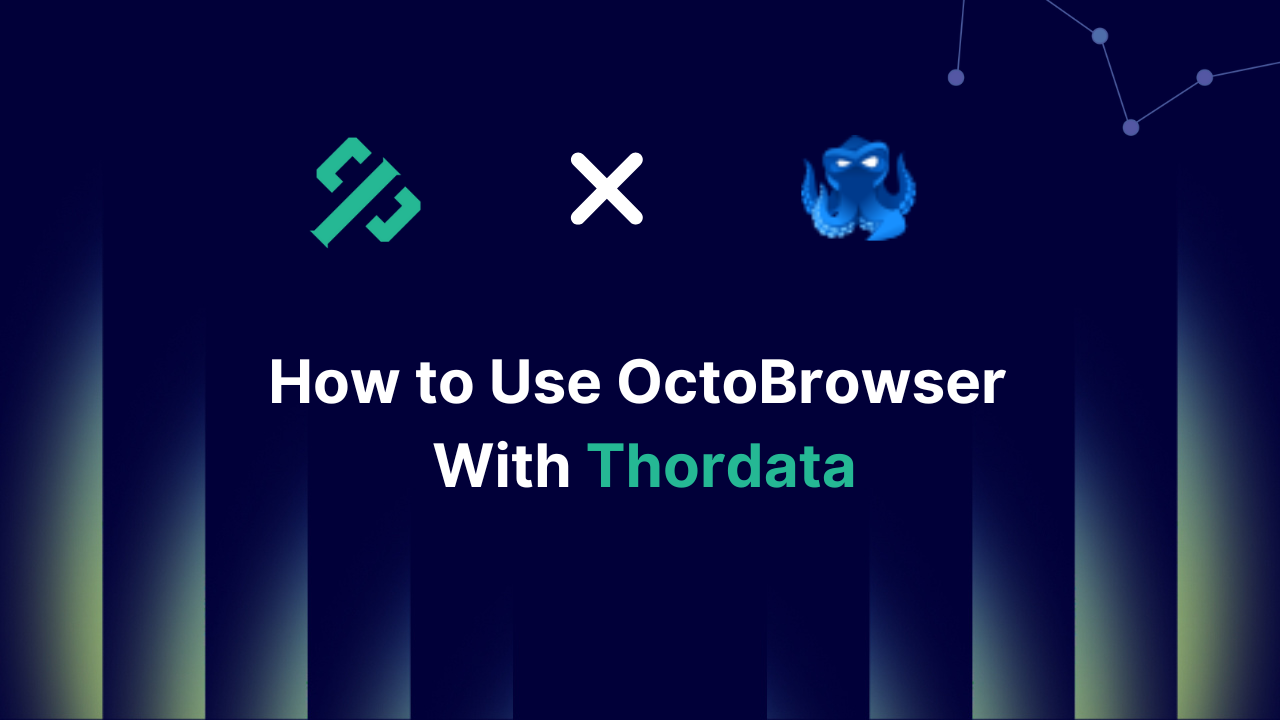

In an era dominated by data security and digital sovereignty, anti-detection browsers have become indispensable for professionals in all walks of life. From digital marketers and affiliate managers to e-commerce entrepreneurs and cybersecurity experts, the demand for tools that can easily manage multiple accounts and protect online anonymity continues to soar.
In this guide, we will cover OctoBrowser’s main features and explain how to integrate it with Thordata Proxy for secure and seamless operation.
What is OctoBrowser?
OctoBrowser is a powerful anti-detection browser designed for multi-account management and online privacy. It enables users to create and manage multiple browser profiles with unique fingerprints, making it ideal for anyone working in automation. With built-in proxy support, team collaboration features, and powerful anti-fingerprinting technology, OctoBrowser ensures safe, efficient, and anonymous browsing on a variety of platforms.
Understanding OctoBrowser’s Capabilities
Advanced Fingerprint Management
Octo Browser offers granular control over browser fingerprints, allowing users to customize parameters such as operating system, screen resolution, timezone, fonts, geolocation, and language settings. This level of customization ensures each browser profile mimics a unique real-world device, enhancing anonymity.
Robust Proxy Integration
The browser supports various proxy protocols, including HTTP, SOCKS5, and SSH. Users can effortlessly add single or bulk proxies, facilitating efficient management of multiple accounts. Integration with IPRoyal proxies further enhances this capability, providing a vast pool of residential IPs for secure browsing.
Automation and Team Collaboration
Octo Browser’s API allows for automation of routine tasks, such as account creation and data scraping, using frameworks like Selenium, Puppeteer, and Playwright. Additionally, its team features enable collaborative work environments, with options to share profiles, assign roles, and track activity history.
How to integrate Thordata with Octobrowser
1. Log in to the official website of OctoBrowser, click Download to download and install
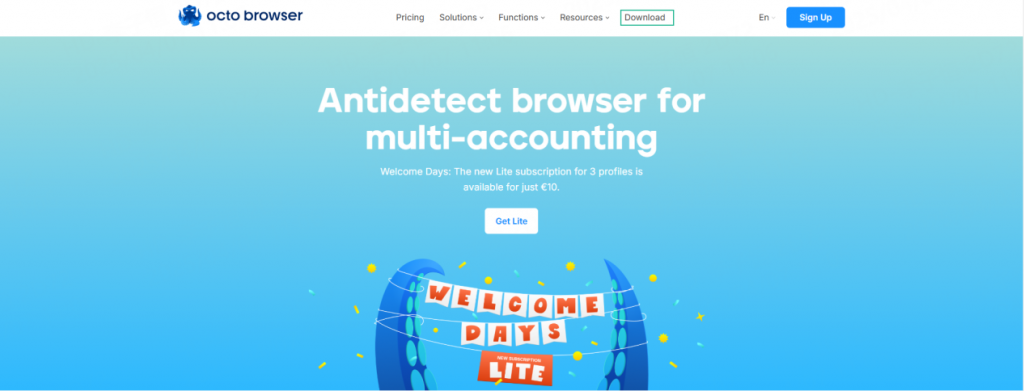
2. Enter the main interface and click [Add Proxy]

3. After selecting Add, select [HTTP] in Proxy Type
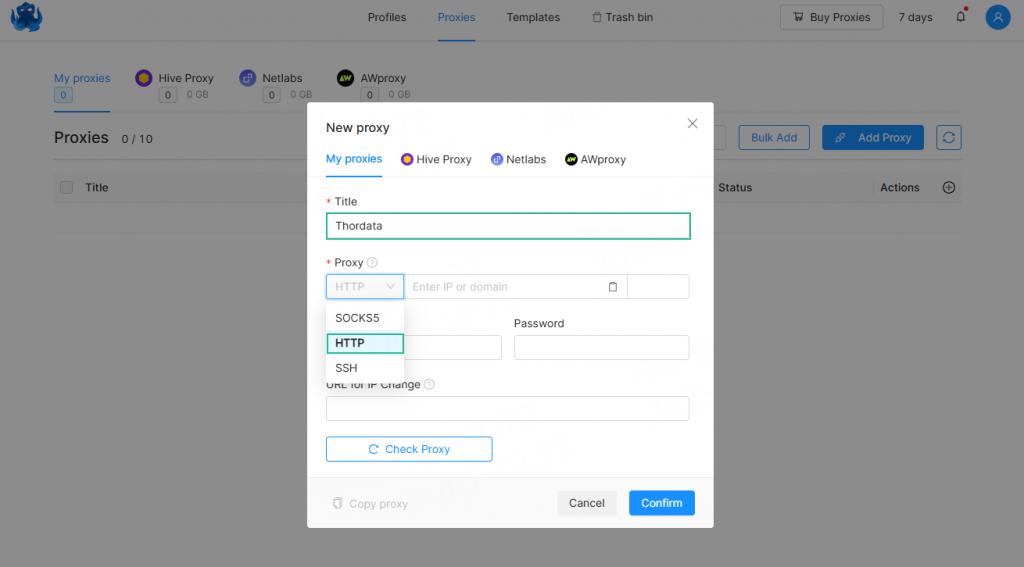
4. Enter the IP and host information. The following is an example.
IP information: t.pr.thordata.net:9999
Login: customer-username
Password: customer-password
After the proxy information is configured, click [Check Proxy] to test. After confirming that the test is successful, click [Confirm] to create it.

5. After successful creation, you can see the IP information on the main interface

Why Thordata Proxies Are Ideal for Octo Browser
|
Feature |
Benefit |
|
Ensures authenticity and untraceable traffic |
|
|
Global Coverage |
Country, region, and city-level targeting |
|
Unlimited Bandwidth |
Perfect for web scraping, automation, and ad verification |
|
Fast Proxy Rotation |
Ideal for high-frequency multi-account operations |
|
Protocol Support |
Full compatibility with HTTP/HTTPS and SOCKS5 |
|
Secure Authentication |
IP Whitelisting and credential-based access |
Conclusion
Octo Browser, when paired with high-quality proxies like those from Thordata, becomes an unstoppable tool for identity management, automation, and global-scale operations. Its depth of customization, advanced fingerprinting, and enterprise collaboration features make it the preferred choice for professionals who demand both power and precision.
To maximize your Octo Browser experience, always use high-trust proxies, maintain operational discipline, and leverage Octo’s automation to reduce human error. The future of anti-detect browsing lies in such integrated, high-performance ecosystems.
Frequently asked questions
How do I use Thordata with Octo Browser?
Add Thordata’s IP and port in Octo Browser’s proxy settings. Each profile gets a unique IP and hidden device info.
Why pair Thordata with Octo Browser?
Stops platforms from banning your accounts. Thordata hides your IP; Octo Browser hides your device’s identity. Simple protection.
Can this help with multiple Amazon/Facebook accounts?
Yes! Each account gets a fake “device” and real-looking IP. Platforms think they’re all separate users. No bans.
About the author
Jenny is a Content Manager with a deep passion for digital technology and its impact on business growth. She has an eye for detail and a knack for creatively crafting insightful, results-focused content that educates and inspires. Her expertise lies in helping businesses and individuals navigate the ever-changing digital landscape.
The Thordata Blog offers all its content in its original form and solely for informational intent. We do not offer any guarantees regarding the information found on the Thordata Blog or any external sites that it may direct you to. It is essential that you seek legal counsel and thoroughly examine the specific terms of service of any website before engaging in any scraping endeavors, or obtain a scraping permit if required.
Top 5 Best Rotating Proxies for 2025: Maximize Your Web Scraping


In today’s rapidly evolving digital landscape, maintaining privacy, accessing geo-restricted content, and scraping large amounts of data are increasingly becoming challenges for businesses and individuals alike. One solution to these challenges is using rotating proxies. They are incredibly powerful tools that help users avoid detection, bypass geo-blocking, and maintain high levels of anonymity.
In this article, we will dive deep into the world of rotating proxies, explore the top providers for 2025, compare their features, and discuss why Thordata Proxy Services stands out as a top choice for businesses and individual users alike.
What Are Rotating Proxies?
Rotating proxies are a type of proxy service that automatically changes your IP address at regular intervals while you are browsing the web. Instead of using a single static IP address, a rotating proxy gives you access to a pool of IPs that change, making it nearly impossible for websites to track or block your activities. This is particularly useful for web scraping, SEO monitoring, ad verification, and privacy protection.
Rotating proxies are commonly used in cases where high anonymity and access to multiple geo-locations are required. Whether you are scraping data, managing social media accounts, or simplyocations are required. Whether you are scraping data, managing social media accounts, or simply trying to access restricted content, rotating proxies are an essential tool in your privacy and web automation arsenal.
Why You Need Rotating Proxies for Your Online Activities
If you’ve ever tried scraping data from websites or managing multiple accounts, you may have encountered IP bans, CAPTCHAs, or rate-limiting. These are common issues when accessing websites from a single IP address. That’s where rotating proxies come in:
Bypass IP Blocks: Websites that detect multiple requests from the same IP will often block that IP. Rotating proxies solve this problem by frequently switching your IP.
Avoid CAPTCHAs: Sites use CAPTCHAs to prevent bots from accessing their pages. Since rotating proxies can change IPs quickly, they help you avoid CAPTCHAs by mimicking real users.
Access Restricted Content: Some websites restrict access based on geographical location. With rotating proxies, you can change your virtual location and bypass geo-restrictions effortlessly.
Web Scraping and Data Mining: When scraping large amounts of data from websites, rotating proxies distribute the requests across different IPs, ensuring that your activity remains undetected.
SEO Monitoring: If you need to track search engine rankings or conduct competitor analysis, rotating proxies allow you to monitor SERPs from different locations without the risk of being flagged as a bot.
The Top 5 Rotating Proxy Providers for 2025
In 2025, many proxy providers will offer reliable rotating proxy services. However, not all are created equal. Here are the top 5 providers that are expected to dominate the proxy market:
1. Thordata
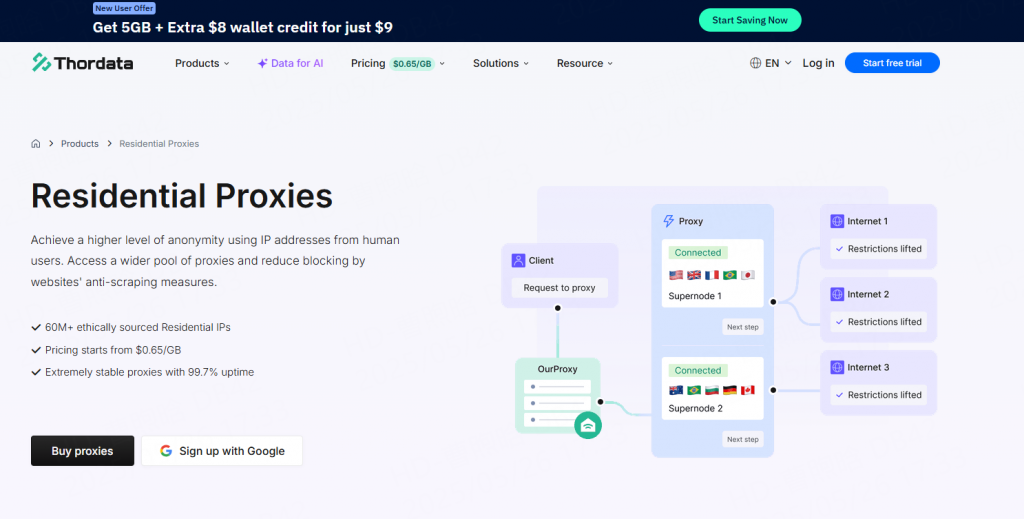
Thordata’s rotating proxies offer high-speed, reliable IP pools with excellent coverage across multiple regions. With over 40 million IPs from residential and mobile IPs, Thordata guarantees anonymity and privacy. Their intelligent proxy rotation ensures that users are never blocked or flagged, making them ideal for web scraping and accessing restricted content. Additionally, they provide 24/7 customer support and robust security features, giving users peace of mind.
Key Features:
Massive IP Pool: Over 40 million IPs.
High Success Rates: Reliable access to geo-restricted content.
Flexible Pricing: Tailored pricing options to suit businesses of all sizes.
Security: Encryption and privacy-focused design.
2. Bright Data
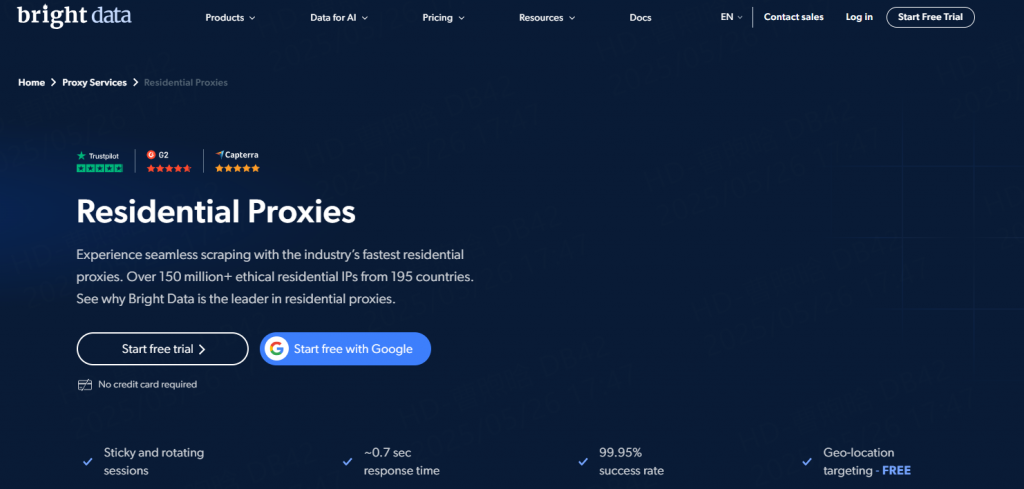
Bright Data is a veteran in the rotating proxy space, offering a vast pool of over 72 million IPs from residential, mobile, and data center proxies. Bright Data offers great flexibility and offers features like automatic IP rotation and location-specific targeting, making it perfect for large-scale data scraping and marketing campaigns.
Key Features:
Large IP Pool: 72 million IPs.
Geo-targeting: Access content from specific countries or regions.
Extensive API: Integration-friendly for businesses and developers.
3. DECODO
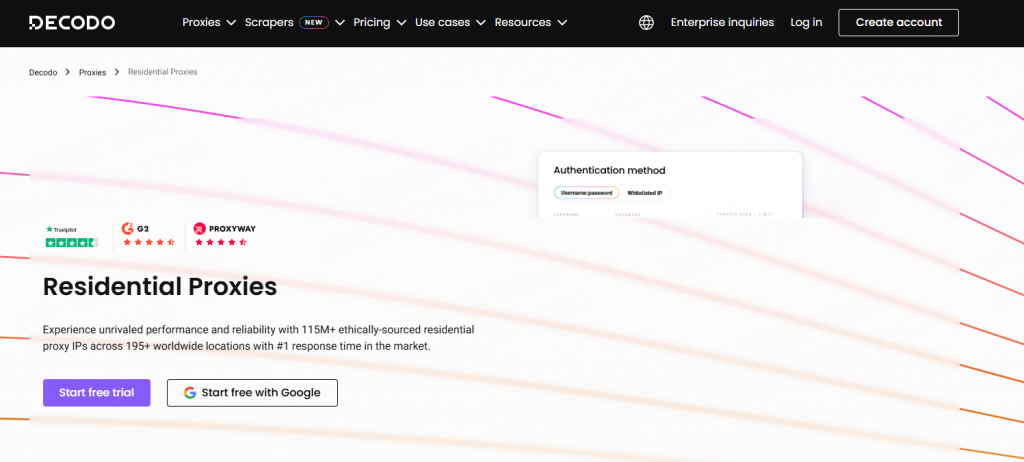
DECODO is another strong contender in the rotating proxy space. With access to more than 40 million residential IPs, DECODO offers competitive pricing and flexible solutions, perfect for both small businesses and large enterprises. Their rotating proxies are known for their speed and high success rates in bypassing restrictions.
Key Features:
Reliable IP Rotation: Rotates IPs at intervals to ensure smooth browsing.
Global Coverage: IPs from 195+ locations worldwide.
Affordable Pricing: Flexible pricing plans suited for all budgets.
4. Oxylabs

Oxylabs is known for providing premium-quality rotating proxies. Their network includes over 100 million residential IPs, and they offer advanced features for businesses involved in heavy web scraping or ad verification. With global IP coverage, Oxylabs is a go-to provider for enterprises needing scalable solutions.
Key Features:
Massive IP Pool: Over 100 Million IPs.
Advanced Features: Proxy rotation schedules, dedicated support.
High Success Rates: Ensures minimal IP blocks.
5. ProxyRack

ProxyRack is a rising star in the proxy provider space. Offering over 3 million IPs, ProxyRack’s rotating proxy service ensures reliable connections for small to medium-sized businesses. Their service is budget-friendly, with several options to fit different needs.
Key Features:
Affordable: Suitable for businesses on a budget.
Fast Proxy Rotations: Ideal for smaller web scraping projects.
Great Support: Excellent customer service with quick response times.
Summary Table: Comparing Top Rotating Proxy Providers
| Provider | IP Pool Size | Geographic Coverage | Pricing | Ideal Use Case |
|---|---|---|---|---|
| Thordata | 60 million+ | 195+ locations | Flexible | Web scraping, privacy, security |
| Bright Data | 72 million+ | Global | Premium | Large-scale scraping, marketing |
| Smartproxy | 40 million+ | 195+ locations | Affordable | SEO monitoring, competitor analysis |
| Oxylabs | 100 million+ | Global | Premium | Enterprise-level scraping |
| ProxyRack | 3 million+ | 165+ locations | Budget | Small businesses, data scraping |
Why Thordata is the Best Choice
When it comes to choosing the right proxy provider, Thordata stands out due to its impressive features and customer-focused approach. Whether you need to scrape large amounts of data, bypass geo-restrictions, or secure your online identity, Thordata’s rotating proxies offer the best performance and security. With an expansive IP pool, flexible pricing plans, and unmatched customer support, Thordata delivers the ideal solution for businesses and individual users.
Conclusion
In 2025, rotating proxies have become indispensable tools for businesses and individuals who value security, anonymity, and access to geo-restricted content. Among the top providers, Thordata offers the best combination of reliability, speed, and customer support. Their large IP pool, high success rates, and robust security features make them the top choice for web scraping, privacy protection, and marketing purposes.
Frequently asked questions
What are rotating proxies and how do they work?
Rotating proxies automatically change your IP address at regular intervals while you are online. This prevents websites from detecting and blocking your activity, making it ideal for web scraping and accessing restricted content.
How do rotating proxies help with web scraping?
Rotating proxies distribute your requests across multiple IP addresses, which reduces the risk of getting blocked by websites when scraping large amounts of data.
Is Thordata’s rotating proxy service affordable?
Yes, Thordata offers flexible pricing plans that are suitable for businesses of all sizes, making it an affordable choice for both small and large projects.
About the author
Jenny is a Content Manager with a deep passion for digital technology and its impact on business growth. She has an eye for detail and a knack for creatively crafting insightful, results-focused content that educates and inspires. Her expertise lies in helping businesses and individuals navigate the ever-changing digital landscape.
The Thordata Blog offers all its content in its original form and solely for informational intent. We do not offer any guarantees regarding the information found on the Thordata Blog or any external sites that it may direct you to. It is essential that you seek legal counsel and thoroughly examine the specific terms of service of any website before engaging in any scraping endeavors, or obtain a scraping permit if required.
Best Anti-Detect Browsers for Online Business 2025
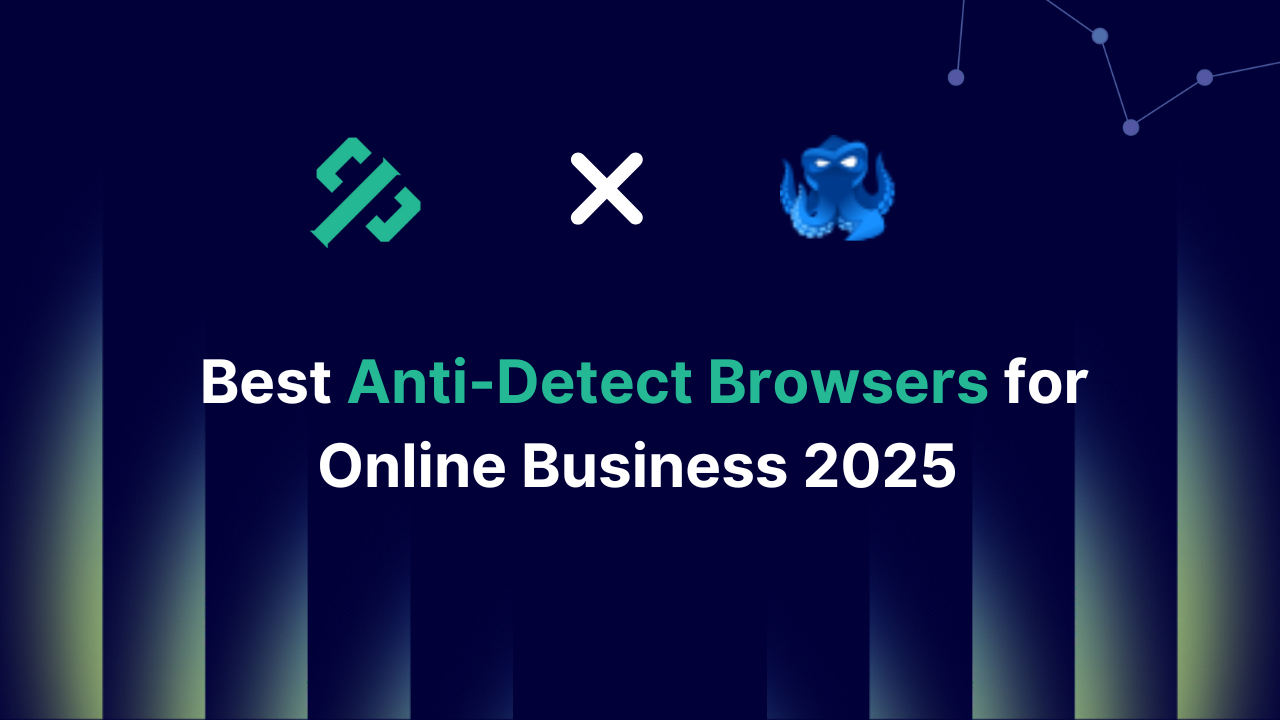

If you’re making money online through affiliate marketing, paid ads, lead gen, or anything that involves managing multiple accounts, you’ve probably run into bans, shadowbans, or sudden restrictions. It’s not just about cookies or IP addresses anymore—platforms track your device fingerprint, browser settings, and even behavior patterns to catch anything that looks suspicious.
The problem? If they flag you, your whole setup can go down in seconds. Ads get paused, accounts get locked, and revenue stops cold. For anyone relying on multi-accounting to scale campaigns or test offers, that kind of attention isn’t just annoying—it’s expensive.
That’s where anti-detect browsers come in. They let you run multiple, completely isolated profiles that look like real users, helping you stay under the radar and avoid detection.
In this article, we’ll compare some of the most popular anti-detect browsers, their features, pricing, and automation tools so you can find the right one for your workflow and experience level.
Best Anti-Detect Browsers 2025
1. Octo Browser
Octo Browser is one of the most reliable anti-detect browsers on the market. It offers powerful fingerprint spoofing by modifying data at the kernel level and using real fingerprints from actual devices. That means the profiles you create in Octo easily pass checks on tools like Pixelscan, BrowserLeaks, and CreepJS.
The browser keeps up with the latest Chromium updates, usually shipping new versions within just a few days, so you’re always in step with the latest detection systems.
Octo is a solid choice to scale, whether you’re just starting or running a team. You can create a new profile instantly or fine-tune over 50 settings manually. The number of devices you use is unlimited, and team access is easy to manage with detailed roles and permissions.
Octo stands out in security, especially if you’re working with crypto wallets, advertising logins, or sensitive client accounts. Octo Browser stores all profile data in encrypted form on secure servers in the EU. Not even the Octo team can see what’s inside your profiles. The way Octo protects your profile data:
● A unique encryption key
● An optional password for extra protection
● End-to-end encryption to keep your data safe at all times
You also get essential tools like proxy setup, tagging, and profile export built in. The browser supports API automation, and you can manually manage cookies or let Octo’s Cookie Robot collect them.
Octo runs on Windows and macOS with flexible pricing that starts at €10 for three profiles.
Pros:
● Data encryption according to the AES standard;
● Referral program;
● Profile passwords;
● Tag navigation;
● Profile templates;
● One-click profile creation;
● Cookie Robot;
● Video stream spoofing;
● Manual text input simulation.
Cons:
● Prices for Starter and Base subscriptions range from $2.9 to $0.79 per profile, which is higher than competitors;
● No straightforward way to purchase additional resources for fixed-rate subscriptions.
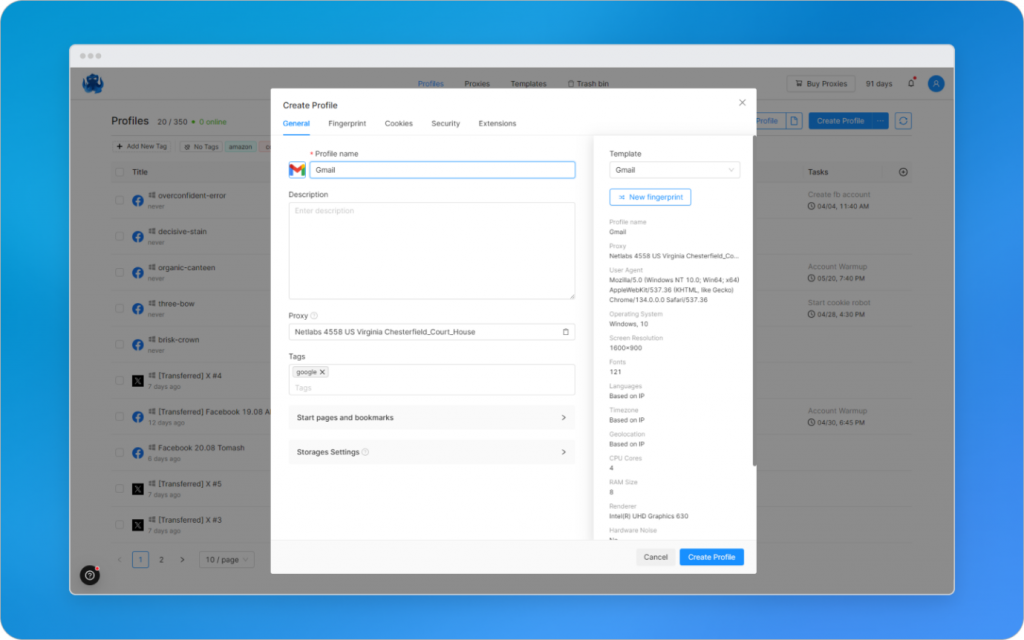
2. Linken Sphere
Linken Sphere takes a unique approach to fingerprint spoofing. Instead of forcing your system to mimic a specific configuration, it does the opposite—it searches for configurations that naturally match your setup. That means less friction and more stable sessions. For users who prefer the classic spoofing method, that option is still available. The browser is designed with teamwork and security in mind. All profile data is stored securely in encrypted cloud storage, and the built-in workspace system makes it easy to collaborate with team members.
Linken Sphere handles the essentials on the automation side: profile transfers, proxy setup, and cookie imports are all supported. It also integrates directly with popular tools like Puppeteer, Selenium, and Postman, which is great for more advanced workflows.
Linken Sphere runs on Windows and macOS, and there are no restrictions on the number of devices or team members you can connect. There’s even a free plan that gives you one profile. Paid plans begin at $30/month for 10 profiles.
Pros:
● Referral program;
● Mobile fingerprints;
● Free proxies;
● Universal profile template;
● Cookie Robot;
● Workspaces;
● Tag and status navigation.
Cons:
● Only cryptocurrency payments;
● On Pure and Light plans, one profile costs $3 and $0.9 respectively;
● No Linux version;
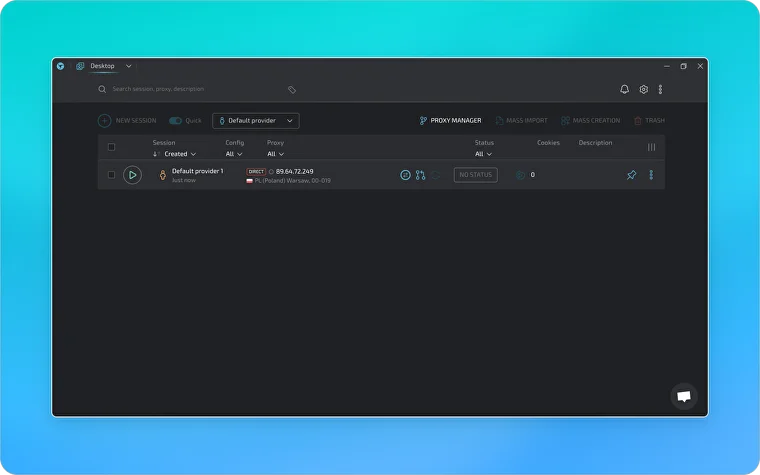
3. Multilogin
Multilogin is one of the more premium options on the market, but it backs that up with powerful fingerprint spoofing, covering key areas like Canvas, WebGL, and more. It supports both Chromium- and Firefox-based profiles, giving users more flexibility depending on their needs.
All profile data is stored securely in the cloud with AES encryption, so sensitive information stays protected. You can create profiles either automatically or configure them manually, and there are built-in tools to help automate tasks on platforms like Google, Facebook, and various e-commerce sites.
Multilogin also facilitates team collaboration with features like profile sharing, transfer, and access controls. You can test the service by creating three profiles for free, and paid plans allow you to create up to 1,000 profiles.
Pros:
● Referral program;
● Mobile fingerprints;
● Encrypted cloud storage;
● Quick profile creation;
● Cookie Robot;
● Text input simulation.
Cons:
● One of the most expensive anti-detect browsers.
● Users report negative experiences with technical support.
● Cannot be installed on Linux.
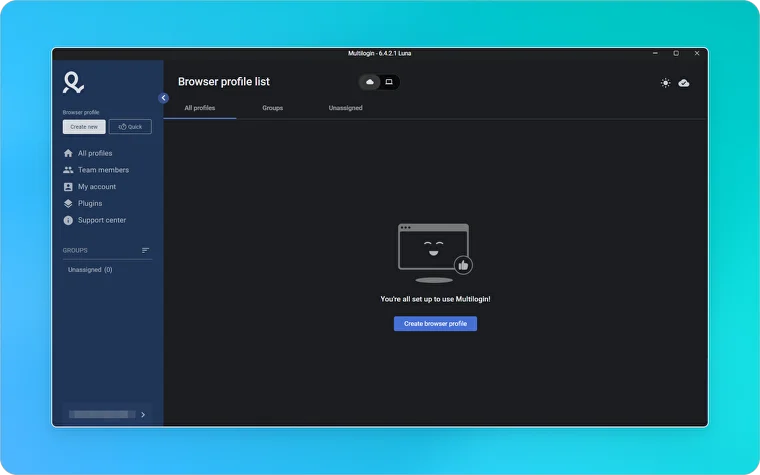
4.GoLogin
GoLogin stands out with its cross-platform flexibility, including a mobile app and a web version. The Android app lets you run one profile at a time (with Orbita installed), while the web app supports up to four active profiles—even on the top-tier plan.
Instead of Chromium or Firefox, GoLogin is built on the Orbita browser. It offers full fingerprint customization and gives each profile its isolated cloud storage, which helps keep your setups secure and organized.
You can create new profiles in seconds, duplicate them, group them for better management, and automate tasks via the built-in API. GoLogin also supports team collaboration with features for sharing profiles, folders, and proxy access.
The app runs on Windows, macOS, and Linux and includes a free plan with three profiles to get started.
Pros:
● Referral program;
● Android mobile fingerprints;
● Manual text input simulation;
● Web version and mobile app for urgent profile launching.
Cons:
● You cannot save, add proxies, or change the OS for profiles created in once click;
● You cannot choose the timezone, user agent, or add proxies in profile templates.
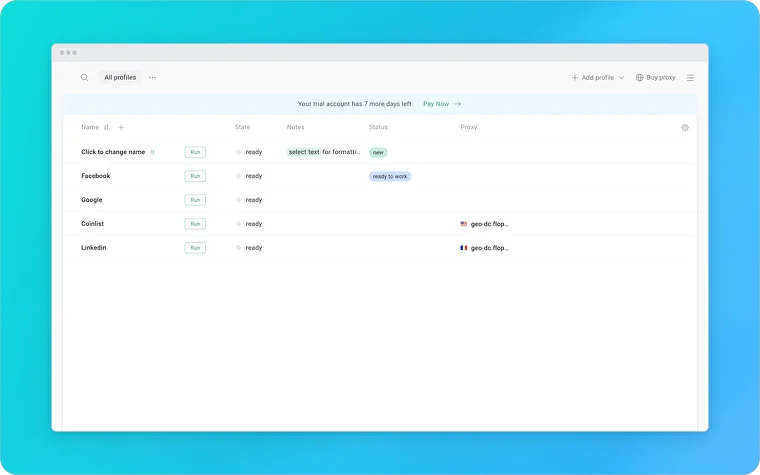
5. Vision
Vision’s design focuses on teamwork capabilities. You can manage multiple teams from a single account and switch between them seamlessly—there is no need to log in and out. Depending on your workflow and security preferences, you can also choose between local storage or encrypted cloud storage.
The browser uses real device fingerprints for more authentic profile behavior and includes all the key tools you’d expect: profile folders, tags, and easy sharing options.
You can install browser extensions across groups of profiles, and Vision supports automation through integration with Puppeteer, Playwright, and Selenium.
It runs on Windows, macOS, and Linux, with team roles and collaboration tools available on most subscription plans.
Pros:
● Referral program;
● Folders, tags, and statuses;
● Secure cloud storage;
● Built-in extension library;
● Cookie Robot;
● Manual text input simulation.
Cons:
● No font and audio hash spoofing.
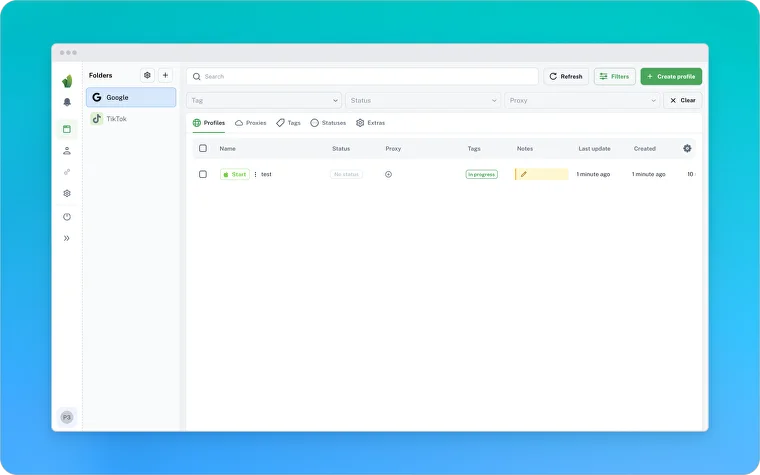
6. AdsPower
AdsPower offers powerful tools like API access, robotic process automation (RPA), and a synchronizer that can mirror your actions across multiple windows in real time. Even if you don’t have coding skills, you can automate clicks, form filling, and other repetitive tasks using RPA scripts.
The browser supports both Chromium and Firefox cores and assigns a unique fingerprint to each profile. Setting up profiles is quick and automatic, and a free version is available for basic needs. Paid plans start at $9 for 10 profiles, and AdsPower runs on Windows and macOS.
However, there’s a significant security concern to be aware of. The AdsPower platform was recently compromised by threat actors who injected malicious code into the system. This code targeted third-party crypto wallet extensions and led to the theft of user funds. Security firm SlowMist estimates that hackers stole around $4.7 million worth of crypto-assets linked to this breach. Because of this incident, AdsPower’s security reputation is questionable, and users should exercise caution, especially when handling sensitive data.
Pros:
● Referral program;
● No-code RPA;
● Profile synchronizer;
● iOS mobile fingerprints;
● Data encryption.
Cons:
● Outdated and congested interface with lots of ads and poor translations;
● The kernel is updated on average once a month, making the users of this browser appear suspicious to anti-fraud systems.
● No automatic updates: new versions need to be installed manually.
● In February 2025 suffered a big data breach occurred where hackers stole almost $5 million crypto-assets.
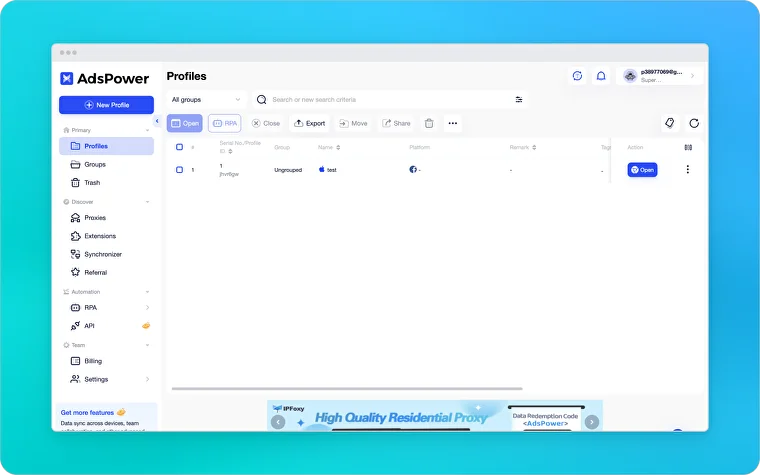
7. Dolphin{anty}
Dolphin{anty} is a popular choice, especially since it offers 10 free profiles with no time limits—great for getting started without a commitment. It has built-in tools for running Facebook ads and features a visual script builder so that you can automate tasks without coding.
Fingerprints are sourced from real devices to help keep profiles authentic. The browser includes essential features like cookie export, tagging, and proxy management.
For automation pros, Dolphin{anty} supports Selenium, Playwright, and Puppeteer through its API. Team management is easy, with roles and permission levels to keep access under control. It runs smoothly on Windows, macOS, and Linux.
Pros:
● Referral program;
● Manual text input simulation;
● Graphic interface for creating scenarios;
● Facebook ad tool.
Cons:
● Cannot spoof fonts, hardware, Audio, and DNS settings;
● No custom templates.
● Profiles on Team and Enterprise plans are more expensive than most competitors.
● In July 2022, there was a leakof 15% of all profile data, and an update in April 2024 caused operational instability.
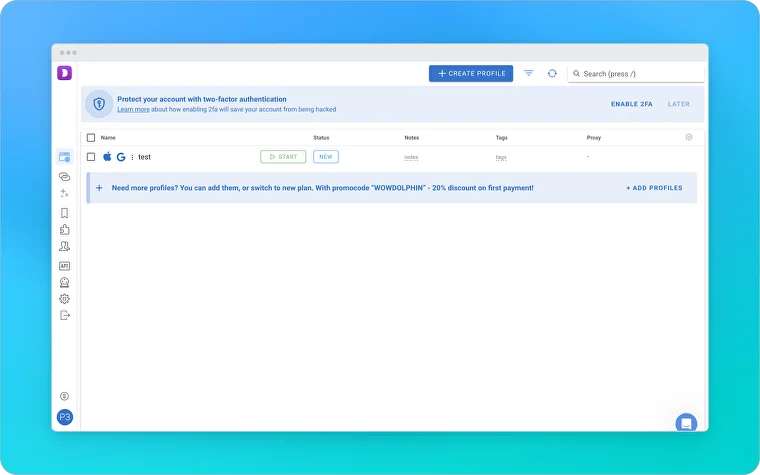
8. Undetectable
Undetectable introduces a unique pricing model. Instead of offering unlimited fingerprints, it sells configurations separately. You can create unlimited local profiles on paid plans, but cloud profiles are limited and require purchasing real fingerprints.
The browser supports API-based automation and includes a synchronizer for repeating actions across windows. A cookie bot and account prep tools are also available. Free users can access five cloud profiles and ten local ones. Undetectable is compatible with Windows and macOS.
Pros:
● Synchronizer;
● Mobile fingerprints for Android and iOS.
Cons:
● Limited number of devices for one account.
● One profile costs almost $1, more expensive than competitors.
● Real fingerprints need to be bought at a minimum of $1 each.
● Not suitable for Linux.
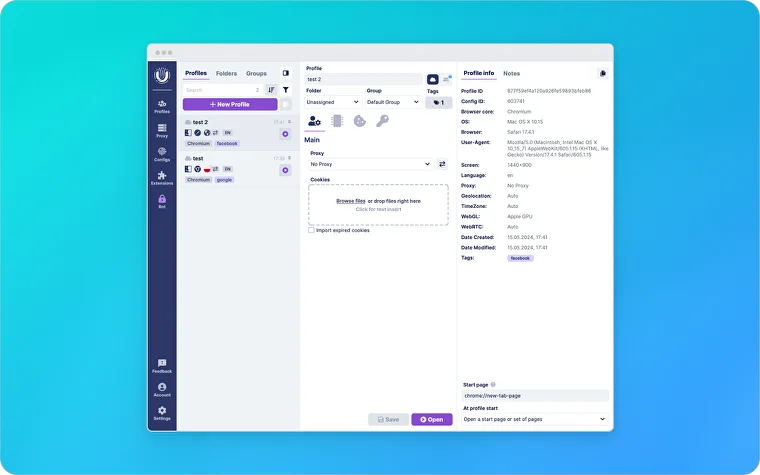
Understanding Thordata and Anti-Detect Browsers
For digital marketers, e-commerce sellers, and multi-account managers, the combo of Thordata proxy services and anti-detect browsers is a game-changer for bypassing platform tracking and ensuring account safety. Thordata’s global IP pool—featuring 60 M+ residential and datacenter IPs across 195+ countries—delivers pristine, region-specific addresses with automatic rotation, shielding your real location while providing the ISP-grade authenticity platforms trust. Paired with fingerprint browsers that mimic unique device profiles (customizing UA strings, hardware signatures, and behavior patterns), this duo creates an impenetrable layer of obfuscation: each account operates in an isolated environment with a “fake” but credible digital identity, slashing detection rates by 90 %+ compared to basic proxies.
Thordata stands out in key areas: Whether you’re managing 10 or 1,000 accounts, the seamless integration ensures zero IP conflicts or fingerprint leaks—ideal for social media automation or ad verification. Trusted by 50,000+ users, Thordata + fingerprint browsers offer a proven solution to scale safely without bans, making it the go-to choice for anyone serious about long-term account security.
Why choose Thordata and Octo?
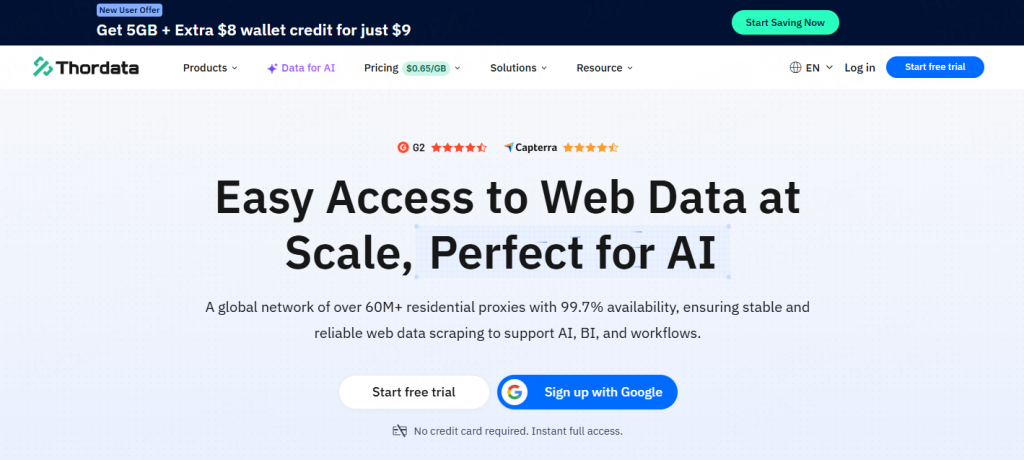
1. Unmatched Fingerprint Spoofing & IP Anonymity for Absolute Account Isolation
In the high-stakes world of multi-account management and cross-border digital operations, exposing your real browser fingerprint or IP address can lead to instant account association and bans. Thordata’s proxy service, combined with advanced anti-detect browsers, creates an impenetrable shield: its global network offers pristine residential and datacenter IPs with automatic rotation, while the browser generates unique fingerprints for each profile—customizing UA strings, time zones, and hardware signatures to mimic real devices. Together, they slash website fingerprint detection accuracy from 78% to under 5%, according to independent testing. This makes the combo ideal for Amazon sellers managing multiple storefronts, social media marketers running brand networks, or affiliate marketers needing airtight profile separation, eliminating platform tracking at the infrastructure level.
2. Seamless Scalability & Global Access for Operational Efficiency
Traditional proxies often fail due to poor IP quality or browser incompatibility, causing frustrating CAPTCHAs and lag. Thordata’s intelligent routing system solves this by automatching the best nodes for your needs—prioritizing high-trust residential IPs for e-commerce or fast datacenter IPs for scraping—paired with anti-detect browsers’ bulk profile management. Each with a unique, regionally consistent online identity. For businesses expanding into global markets or accessing geo-restricted content, this means zero manual IP switching or environment debugging: built-in automation APIs cut setup time by 80%, letting you focus on scaling operations instead of technical hassles.
3. Enterprise-Grade Platform Compatibility & Adaptive Defense
High-risk platforms like Facebook Ads, Google Marketing, and Shopify impose strict 风控 (risk control), but Thordata + anti-detect browsers thrive where others fail. Thordata’s ISP-grade IPs come with full ASN records and regional consistency, while the browser adds behavioral obfuscation—mimicking natural mouse movements and page dwell times to confuse AI-driven detection systems. The real edge? Thordata’s live IP risk monitoring weeds out compromised addresses in real time, replenishing the pool with fresh nodes, while the browser updates its fingerprint library regularly. This creates a “3D defense” of dynamic IPs, variable fingerprints, and human-like behavior—future-proofing your operations against evolving platform algorithms. Say goodbye to single-point failures and hello to long-term, reliable account security for your most critical digital assets.
Conclusion
Picking the right anti-detect browser matters most for your work, advanced automation, precise fingerprint spoofing, flexible pricing, or robust team collaboration features. Some options are perfect for individuals just starting, while others are built to support large teams managing hundreds of accounts daily.
No matter your setup, using an anti-detect browser alongside reliable, high-quality proxies is key to staying anonymous and keeping your sessions stable. With the right tools, you can protect your digital identity, scale your projects, and avoid bans or account suspensions across platforms.
Frequently asked questions
How do I use Thordata with Octo Browser?
Add Thordata’s IP and port in Octo Browser’s proxy settings. Each profile gets a unique IP and hidden device info.
Why pair Thordata with Octo Browser?
Stops platforms from banning your accounts. Thordata hides your IP; Octo Browser hides your device’s identity. Simple protection.
Can this help with multiple Amazon/Facebook accounts?
Yes! Each account gets a fake “device” and real-looking IP. Platforms think they’re all separate users. No bans.
About the author
Jenny is a Content Manager with a deep passion for digital technology and its impact on business growth. She has an eye for detail and a knack for creatively crafting insightful, results-focused content that educates and inspires. Her expertise lies in helping businesses and individuals navigate the ever-changing digital landscape.
The Thordata Blog offers all its content in its original form and solely for informational intent. We do not offer any guarantees regarding the information found on the Thordata Blog or any external sites that it may direct you to. It is essential that you seek legal counsel and thoroughly examine the specific terms of service of any website before engaging in any scraping endeavors, or obtain a scraping permit if required.
HTTP vs SOCKS Proxy Explained: Key Differences and Use Cases
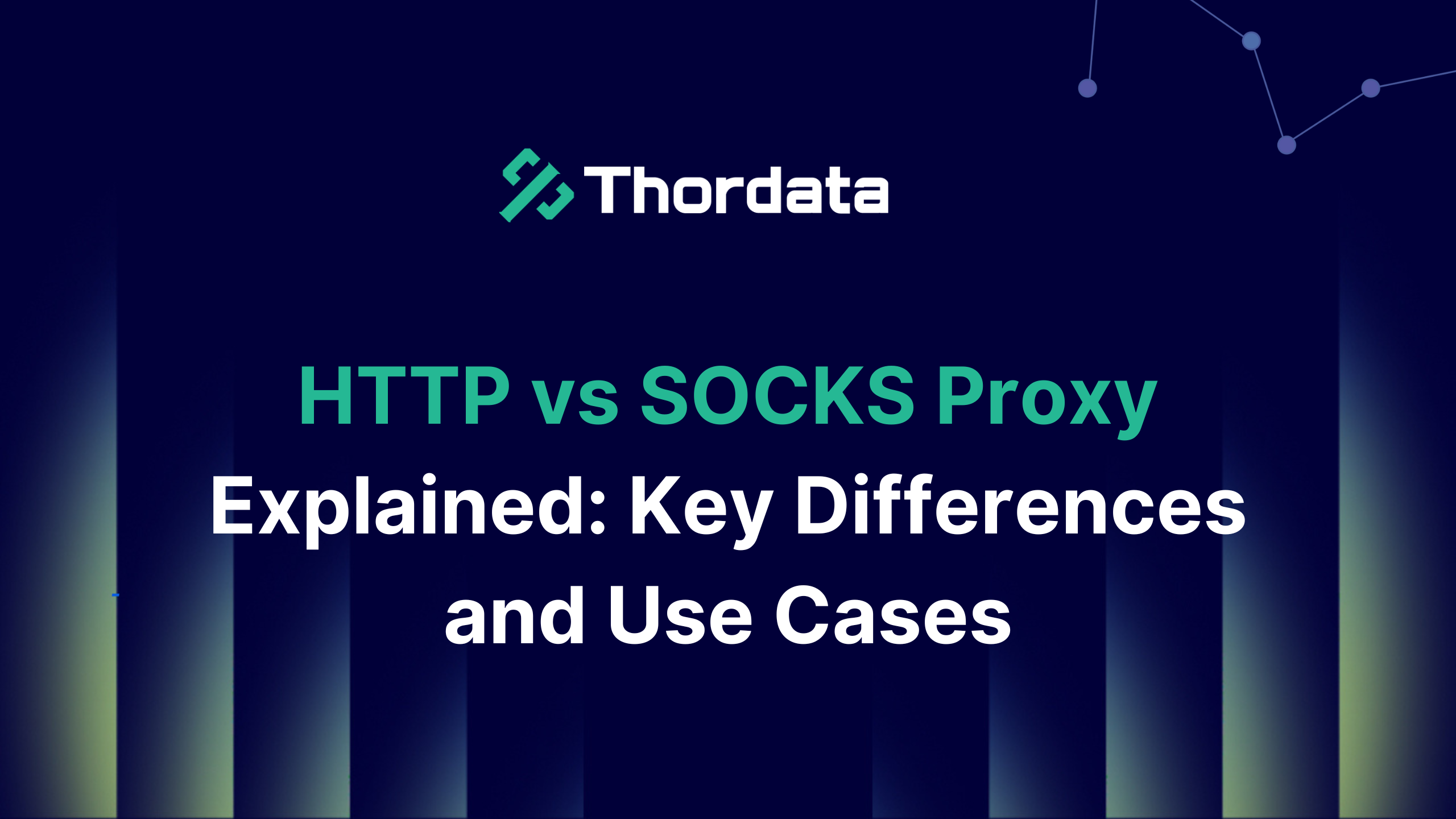

HTTP and SOCKS proxies both act as middlemen between you and the internet, but they operate in fundamentally different ways. HTTP proxies specialize in web traffic, interpreting HTTP data to enable content filtering and caching capabilities. SOCKS proxies, on the other hand, work as universal tunnels, handling various internet protocols including TCP, UDP, and DNS without inspecting the content.
In this article, you’ll learn about the critical distinctions between these proxy types and their ideal applications. Whether you need to bypass geographic restrictions, enhance your online privacy, or boost application performance, understanding each proxy’s strengths and limitations helps you make the right choice for your specific needs.
What is an HTTP Proxy and How Does It Work?
HTTP protocol basics
The Hypertext Transfer Protocol (HTTP) serves as the foundation for data communication on the web. HTTP operates as a request/response protocol enabling communication between clients (usually browsers) and servers. When you enter a URL in your browser, your device creates a TCP connection on Port 80—the standard port for HTTP traffic. The HTTP server then receives your request and sends back the requested content, an error message, or other information.
Standard HTTP communication lacks encryption, unlike its secure variant HTTPS. This means data exchanged between your device and web servers remains open to interception.
How HTTP proxies handle web traffic
An HTTP proxy acts as a mediator positioned between clients and web servers. When you set up your device to use an HTTP proxy, the following process occurs:
1.Your web request travels to the proxy server instead of the destination server
2.The proxy evaluates the request based on its configured rules and policies
3.If the request meets the proxy’s criteria, it forwards the request to the target web server, typically replacing your IP address with its own
4.The web server processes the request and returns the response to the proxy
5.The proxy receives the response and delivers it back to your device
During this process, HTTP proxies can modify both requests and responses. They might filter content, block specific URLs, or cache frequently accessed data to boost performance. Additionally, the proxy masks your IP address, making your web activities appear to come from the proxy’s location rather than your actual location.
What is a SOCKS Proxy and How Is It Different?
Understanding the SOCKS protocol
The SOCKS protocol works at Layer 5 (session layer) of the OSI model, establishing a transparent tunnel between client and server. This lower-level operation enables SOCKS to handle virtually any type of network traffic from any protocol or program. Unlike HTTP proxies that only manage web traffic, SOCKS proxies can route connections using multiple internet protocols across any port.
When you configure a device to use a SOCKS proxy, your traffic routes through the proxy server via a TCP connection. The proxy server forwards all data packets between your device and the destination server, masking your original IP address in the process. The key distinction here is that SOCKS proxies don’t interpret or modify the data—they simply pass the traffic through without trying to understand its content.
SOCKS4 vs SOCKS5 explained
The SOCKS protocol has evolved through several versions, with SOCKS4 and SOCKS5 being the most commonly used today. These versions differ significantly in their capabilities:
SOCKS4:
Handles only TCP connections
Lacks authentication mechanisms (relies on IP-based verification)
Cannot resolve domain names (resolution happens on the client side)
Does not support UDP traffic or IPv6 addresses
Generally faster but offers fewer security features
SOCKS5:
Supports multiple authentication methods, including username/password and GSS-API
Handles both TCP and UDP connections (essential for video streaming applications)
Offers built-in DNS resolution capabilities
Works with IPv6 addresses
Can create more secure connections using SSH tunneling
Supports subnet routing and proxy chaining for enhanced anonymity

SOCKS vs HTTP Proxy: Key Technical Differences
The technical architecture of HTTP and SOCKS proxies reveals fundamental differences that determine their performance in various scenarios. These differences affect everything from connection methods to data handling capabilities.
Data interpretation and caching
The way each proxy handles data creates a clear distinction between them. HTTP proxies operate at a higher abstraction level, allowing them to interpret web traffic, analyze errors, filter content, and cache frequently accessed data. SOCKS proxies take a completely different approach – they don’t modify data packet headers or interpret content. They simply establish connections and transfer bytes between client and server without performing any content inspection.
Authentication methods
Authentication capabilities vary considerably between these proxy types. HTTP proxies typically implement basic authentication methods through HTTP headers. SOCKS5, however, supports multiple authentication mechanisms including:
Username/password verification
GSS-API authentication
Null authentication (no credentials required)
Various other methods
This flexibility makes SOCKS5 more adaptable to different security environments than both HTTP proxies and SOCKS4, which completely lacked authentication support.
Speed and latency
Performance differences stem directly from their architectural design. HTTP/HTTPS proxy servers often introduce higher latency than SOCKS proxies since they process and interpret traffic before forwarding it. They may also add extra headers and modify content, increasing packet size and complexity. SOCKS proxies, with minimal data processing requirements, generally deliver better speed for large data transfers, making them ideal for P2P sharing and streaming applications.
Security and encryption
Despite speed advantages, neither proxy type includes built-in encryption. However, SOCKS5 can establish more secure connections using TCP authentication with encrypted SSH tunneling. HTTP proxies excel at detecting and filtering suspicious content but might expose more client information to web servers through HTTP headers, potentially compromising anonymity unless properly configured.
Use Cases: When to Use HTTP vs SOCKS Proxies
Choosing the right proxy depends largely on your specific use case rather than technical specifications alone. Let’s examine the scenarios where each proxy type performs best.
Web browsing and scraping
HTTP proxies deliver exceptional results for web scraping operations. Their ability to interpret and modify HTTP headers significantly boosts scraper success rates. These proxies excel at:
Content filtering – removing unnecessary elements from web pages
Header modification – customizing request headers to avoid detection
Data cleaning – extracting only relevant information from websites
Security enhancement – detecting and blocking malicious data packets
These capabilities make HTTP proxies particularly valuable for businesses focused on data collection and analysis. The content filtering functionality protects your scraping infrastructure while improving the quality of extracted data.
Streaming and P2P sharing
SOCKS proxies dominate in streaming and peer-to-peer file sharing applications. Their UDP protocol support provides crucial advantages:
Faster data transmission without session acknowledgment requirements
Reduced overhead from eliminating error correction processes
Superior performance for real-time protocols like RTSP and VoIP
SOCKS5 specifically handles high-bandwidth applications with remarkable efficiency, making it the go-to choice for video streaming services and torrenting. The minimal processing requirements allow these proxies to transfer large data volumes more quickly than HTTP alternatives.
Bypassing firewalls and geo-blocks
SOCKS proxies excel at circumventing network restrictions and geographic limitations. Their protocol-agnostic nature enables them to work with any port number, effectively bypassing network-level blocks. When you need to access region-restricted content, connecting through a SOCKS proxy in the target country typically yields the best results.
The ability to establish connections between firewalled clients and external servers makes SOCKS proxies particularly effective at accessing restricted content without security compromises. This flexibility explains why they’re widely used for bypassing sophisticated network restrictions.
Enterprise-level security needs
Corporate environments with strict security requirements often benefit from HTTP proxies’ robust filtering capabilities. These proxies can:
Analyze incoming traffic for malicious content
Filter suspicious data packets and potential threats
Cache frequently accessed content to reduce server load
Enforce content policies across organizational networks
The caching functionality proves especially valuable for international content distribution networks, improving performance while maintaining tight security controls. This combination of features makes HTTP proxies the standard choice in many business security frameworks.
Conclusion
The key differences between HTTP and SOCKS proxies matter significantly when choosing the right tool for your specific use case. Throughout this article, you’ve seen how these proxy technologies serve complementary roles rather than competing alternatives.
Your choice between HTTP and SOCKS proxy setups depends entirely on your specific requirements. For standard web browsing with content filtering needs, HTTP proxies work exceptionally well. For mixed protocol environments or bandwidth-intensive applications, SOCKS proxies typically deliver better performance.
Frequently asked questions
What is an HTTP proxy?
An HTTP proxy is a server that acts as an intermediary between a client and a web server, forwarding HTTP requests and responses. It is mainly used for accessing websites, filtering content, improving performance through caching, and hiding the client’s IP address.
What is an SOCKS5 proxy?
A SOCKS5 proxy is a type of proxy server that routes all kinds of internet traffic—such as web browsing, emails, file transfers, and torrents—between a client and the destination server without interpreting the data.
Which is better: SOCKS5 or HTTPS?
Whether SOCKS5 or HTTPS (HTTP proxy over SSL/TLS) is better depends on your use case.If you need broader protocol support and anonymity, go with SOCKS5. For secure, web-only proxy use (e.g., content filtering or enterprise control), HTTPS may be better.
About the author
Yulia is a dynamic content manager with extensive experience in social media, project management, and SEO content marketing. She is passionate about exploring new trends in technology and cybersecurity, especially in data privacy and encryption. In her free time, she enjoys relaxing with yoga and trying new dishes.
The thordata Blog offers all its content in its original form and solely for informational intent. We do not offer any guarantees regarding the information found on the thordata Blog or any external sites that it may direct you to. It is essential that you seek legal counsel and thoroughly examine the specific terms of service of any website before engaging in any scraping endeavors, or obtain a scraping permit if required.
Which Are the Best USA Proxies in 2025?


When searching for US proxies, you will find a variety of options designed for specific use cases. These US proxies allow you to seamlessly access region-specific content while protecting your online privacy. In this guide, you will learn about leading US proxy providers, explore the different types of proxies available in 2025, and understand how to choose the right solution based on your specific requirements. Let’s first examine why US proxies have become such valuable digital assets.
Top reasons to buy USA proxies in 2025
By 2025, the development of US proxies will have far exceeded simple IP masking tools. Today, they serve as complex business solutions with highly specialized applications. Let’s look at why high-quality US proxies are a strategic investment for both companies and individuals.
Access to US-Only Websites and Streaming Platforms
Bypassing geographic restrictions remains one of the most powerful applications of US proxies. By using IP addresses located in the US, you can unlock US-specific e-commerce websites, promotions, and regional pricing, providing international users with the same shopping experience as US consumers. In addition to entertainment, US proxies also provide access to financial services, educational resources, and research databases that maintain country-specific access controls.
Running Ad Verification and Brand Protection
For businesses, US proxies are essential tools for brand protection and ad verification in the US market. Companies can anonymously verify that their ads are displayed correctly in different locations across the US, ensuring that campaigns are presented accurately and comply with regional standards. Brand protection efforts also benefit from US proxy networks. With residential proxies, businesses can monitor brand mentions on social media and forums, analyze competitors without revealing their identity, and detect counterfeit products or unauthorized sales.
Managing Multiple Social Media Accounts
Social media management has become one of the most common applications of US proxies, especially mobile proxies that provide a unique IP address for each account. This setup allows marketers to create and maintain multiple social media accounts without triggering the security measures of platforms that typically flag multiple logins from the same IP address.
Conducting Market Research and Price Monitoring
US proxies enable businesses to conduct thorough market research by analyzing US-only applications, websites, and advertising platforms. Companies can check local SEO rankings, gather consumer sentiment data, and monitor pricing strategies of US retailers.
Price monitoring is particularly effective with US proxies, as they allow businesses to track pricing of competitors in different regions of the US in real-time. This capability helps companies optimize their pricing strategies, identify regional pricing changes, and collect competitive intelligence without being detected or blocked.
Types of Available US Proxies
Residential Proxies
Residential proxies use IP addresses assigned to real homes and devices by legitimate Internet Service Providers (ISPs) in the US. Their main advantage lies in their authenticity—websites recognize these connections as legitimate users rather than automated tools, significantly reducing blocks and CAPTCHAs when accessing protected content.
Datacenter Proxies
Unlike residential options, datacenter proxies operate from cloud data centers rather than residential internet connections. They are ideal for large-scale data extraction projects that do not require extreme anonymity, offering higher speeds and lower costs.
ISP Proxies
ISP proxies, also known as static residential proxies, represent a solution that combines the speed of data centers with the legitimacy of residential addresses. ISP proxies shine when managing multiple accounts, conducting thorough market research, or performing ad verification tasks that require high-speed connections and reliable identity masking.
Best US Proxy Providers to Consider
1. Thordata
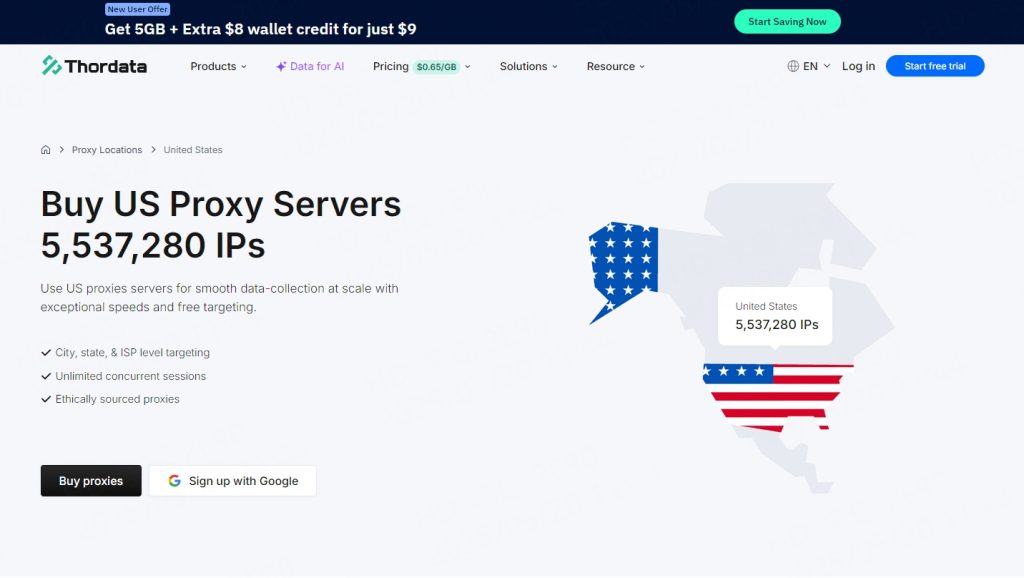
Thordata controls a massive US proxy network of 5.5 million IPs. Its standout feature is extremely precise targeting – down to the city, state, and even zip code level. Enterprise users enjoy superior performance, 99.99% network uptime, and comprehensive proxy management tools. Residential proxies start as low as $0.65/GB, with flexible subscription payment options.
Key Features:
Proxy Types: Residential Proxies, Datacenter Proxies, ISP Proxies
Protocols: HTTP, HTTPS, SOCKS5
Network Size: 60 million IPs across 195+ countries/regions, supports free geo-targeting at the country, city, state, and ASN levels
USA Residential Proxy Pricing: Starting from $0.65/GB
Support: 24/7 live chat, email support, dedicated account manager
Free Trial: Available for 3 days after contacting support
Other Benefits: Dashboard with data statistics, extensive documentation, third-party software integration, free geo-targeting, browser extension
2. Oxylabs
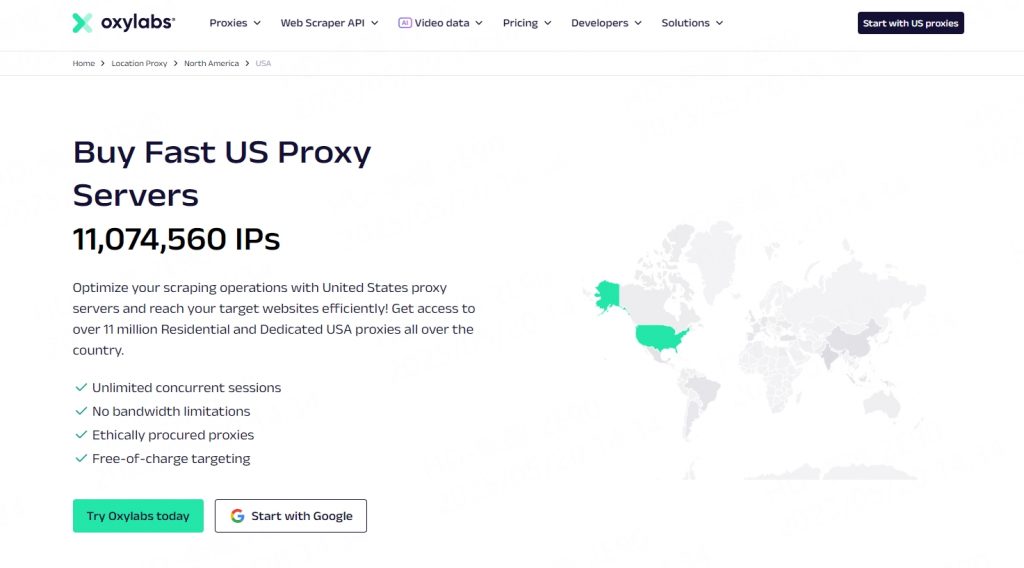
Oxylabs is another heavyweight in the proxy market, known for its reliable residential and datacenter proxies. It provides a robust network designed for high-volume data scraping. With advanced features like session control and intelligent IP rotation, Oxylabs is an ideal choice for enterprises needing large-scale web scraping solutions. Its comprehensive API and excellent customer support make integration seamless, although its premium pricing may not suit all budgets.
Key Features:
Proxy Types: Residential, Datacenter, Mobile, ISP Proxies
Protocols: HTTP, HTTPS, SOCKS5
Network Size: 100 million IPs across 195+ countries/regions, supports geo-targeting
USA Residential Proxy Pricing: Starting from $8/GB
Support: 24/7 live chat and email support
Free Trial: 7-day free trial for enterprise users only
Other Benefits: User-friendly dashboard, free quick-start guide, downloadable datasets, scraping API, browser extension
3. Bright Data
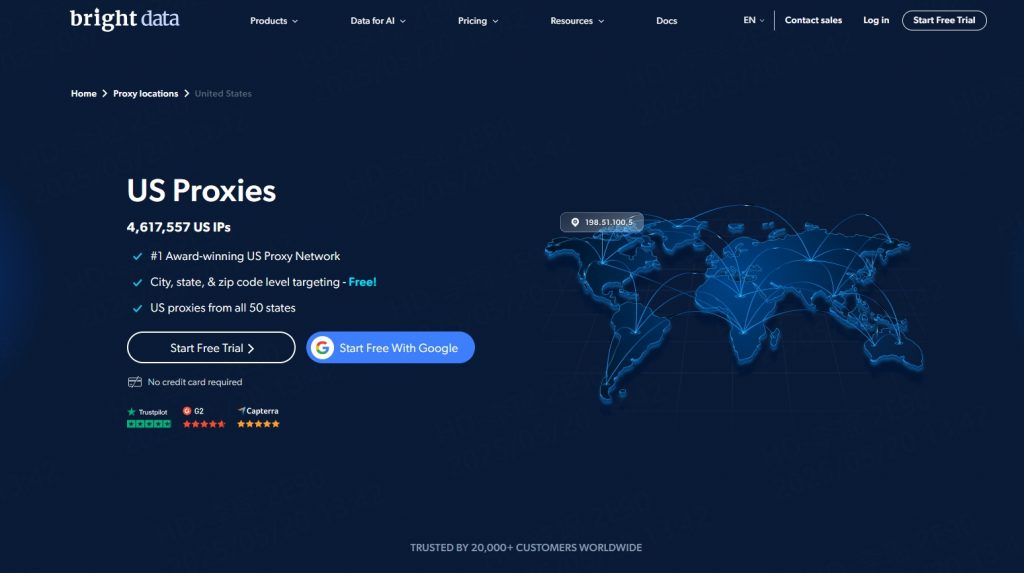
Formerly known as Luminati, Bright Data remains a dominant force in the proxy industry. It offers a wide range of proxy types, including residential, mobile, and datacenter proxies, making it highly versatile. Bright Data is widely praised for its extensive network and detailed usage analytics, which help users optimize their scraping strategies. However, its complexity and cost may pose challenges for smaller businesses.
Key Features:
Proxy Types: Residential, Datacenter, Mobile, ISP Proxies
Protocols: HTTP, HTTPS, SOCKS5
Network Size: 72 million IPs across 195+ countries/regions, supports geo-targeting
USA Residential Proxy Pricing: Starting from $4.2/GB
Support: 24/7 live chat and email support
Free Trial: 7-day free trial available
Other Benefits: Proxy management dashboard, desktop proxy manager app, free proxy options, downloadable datasets, browser extension, scraping browser API
4. Smartproxy
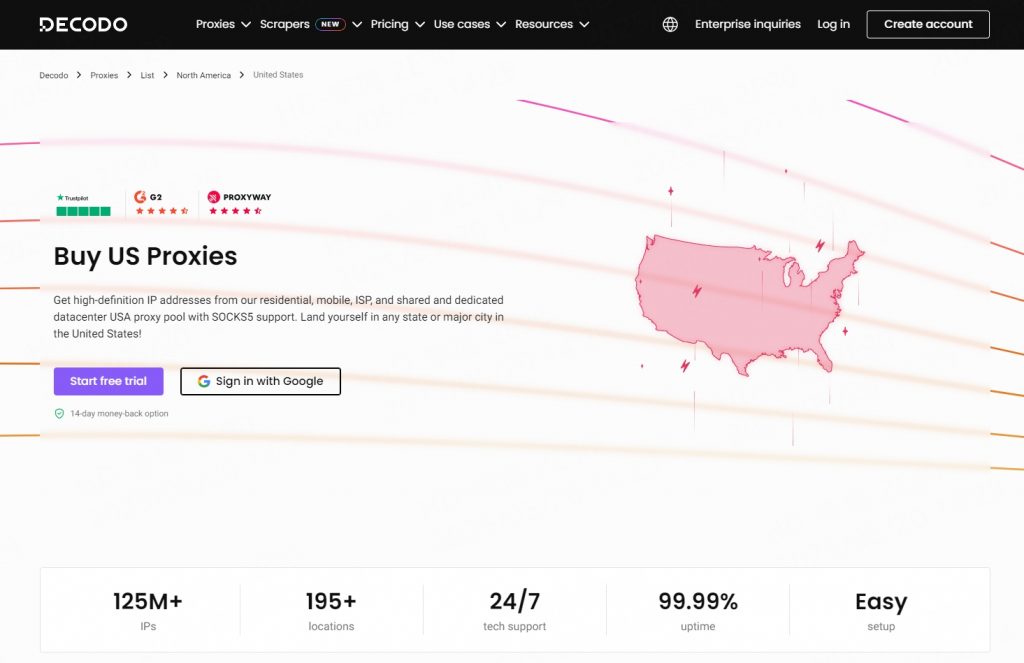
Smartproxy (now operating as Decodo) is known for its user-friendly interface and intelligent management system, providing fast deployment and real-time monitoring capabilities. It offers reliable usa residential proxies with global coverage. Its automatic rotation and robust API integration enable seamless data collection, while its customer support and clear documentation make it easy for beginners to get started.
Key Features:
Proxy Types: Residential, Datacenter, Mobile, ISP Proxies
Protocols: HTTP, HTTPS, SOCKS5
Network Size: 72 million IPs across 195+ countries/regions, supports geo-targeting
USA Residential Proxy Pricing: Starting from $7/GB
Support: 24/7 live chat and email support, enterprise account managers
Free Trial: 7-day free trial available
Other Benefits: Comprehensive documentation, proxy management tools, website unblocker, scraping API
5. Luna Proxy
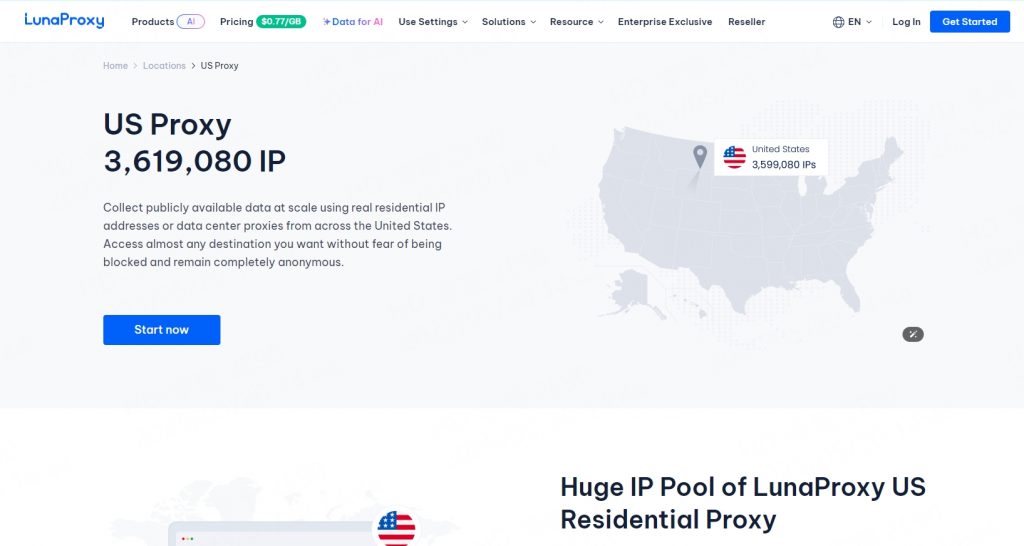
Luna Proxy leverages innovative technology to provide USA residential proxies, emphasizing seamless integration and real-time monitoring. With an intuitive interface and user-friendly operation, it is ideal for ad verification, web scraping, and digital marketing. It offers competitive pricing plans, ensuring users can access high-quality proxies without overspending, making it suitable for small to medium-sized projects.
Key Features:
Proxy Types: Residential, Datacenter, Dynamic ISP, ISP Proxies
Protocols: HTTP, HTTPS, SOCKS5
Network Size: 200 million IPs across 195+ countries, supports geolocation
USA Residential Proxy Pricing: Starts from $0.77/GB
Support: 24/7 live chat and email support
Free Trial: 7-day free trial available
Additional Benefits: User-friendly dashboard, proxy management platform, onboarding documentation, browser extension
6. SOAX
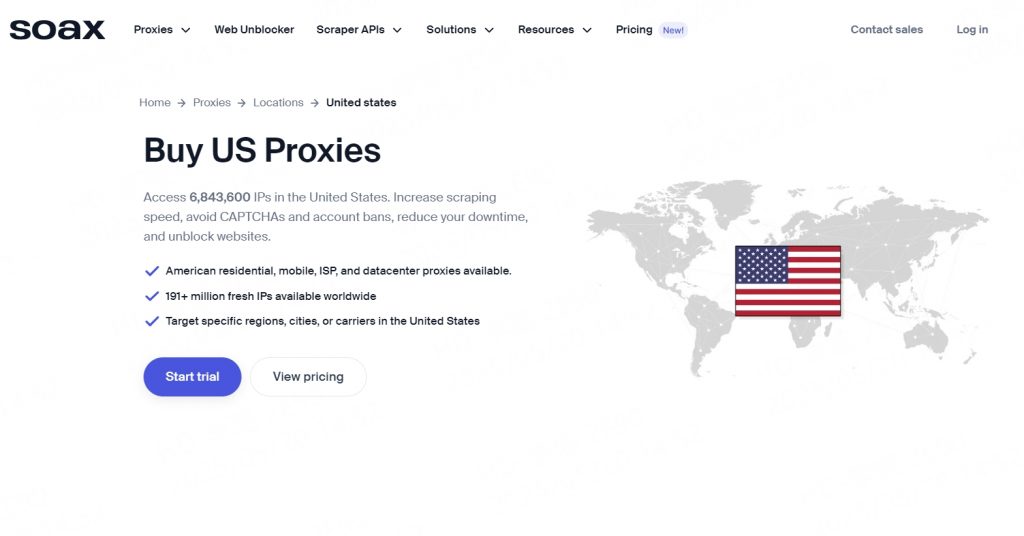
SOAX offers high-quality proxy IPs with regularly updated databases, supporting residential, mobile, and Datacenter proxies. The platform features a clean interface and flexible configuration, making it suitable for web scraping, ad verification, and other applications. While its pricing is slightly higher, its stability and security make it ideal for users requiring top-tier IP quality.
Key Features:
Proxy Types: Residential, Datacenter, Mobile, ISP Proxies
Protocols: HTTP, HTTPS, SOCKS5
Network Size: 155 million IPs across 195+ countries, supports geolocation
USA Residential Proxy Pricing: Starts from $2/GB
Support: 24/7 live chat and email support
Free Trial: No free trial, but a $1.99 trial version is available
Additional Benefits: User-friendly dashboard, proxy management platform, web unblocker, third-party integrations
7. IPRoyal
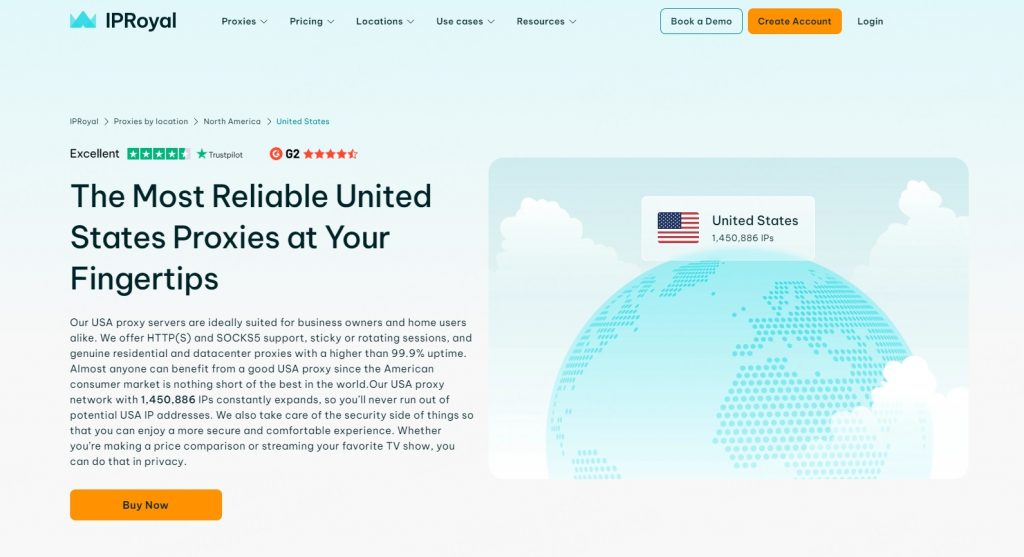
IPRoyal specializes in premium residential proxies with authentic, low-ban-rate IPs that ensure high anonymity. It supports flexible API access, making it suitable for data scraping, ad verification, and market research. While the service is stable, its slightly higher pricing makes it more suitable for professional users with strict proxy quality requirements.
Key Features:
Proxy Types: Residential, Datacenter, Mobile, ISP Proxies
Protocols: HTTP, HTTPS, SOCKS5
Network Size: 72 million IPs across 195+ countries, supports geolocation
USA Residential Proxy Pricing: Starts from $3.5/GB
Support: 24/7 live chat and email support
Free Trial: Not available
Additional Benefits: User-friendly dashboard, proxy management platform, onboarding documentation, API access
How to Evaluate and buy US Proxies
Finding the right US proxy requires a systematic assessment of several key factors. Let’s check the critical criteria you should consider before making a purchase decision.
Check IP Pool Size and Location Options
First, assess the breadth of the provider’s IP network. Top providers offer extensive coverage across all states in the US, major metropolitan areas, and specific postal codes for precise targeting.
Compare Pricing and Trial Availability
Next, carefully evaluate the cost structure and trial options before committing resources. Many quality providers offer free trial periods—Thordata provides a free testing period. Testing before purchase helps confirm that the proxies meet your specific requirements.
Look for Uptime Guarantees and Support
The industry standard for uptime guarantees is 99.7%. Also, assess the quality of the control panel interface used for managing IPs, monitoring usage statistics, and adding funds. Responsive 24/7 technical support becomes crucial when addressing inevitable proxy issues.
Read User Reviews and Trust Ratings
Customer experiences provide valuable insights into the actual quality of service. Check Trustpilot ratings before committing.
Conclusion
We also examined the various types of proxies available, each offering unique advantages based on your specific requirements. When choosing a provider, quality is more important than price. Carefully evaluating uptime guarantees, bandwidth policies, and user reviews can help you find the perfect match for your specific needs.
Frequently asked questions
What is a US Proxy?
A US proxy (United States proxy) is a server located in the United States that acts as an intermediary between your device and the internet. When you connect to the internet through a US proxy, websites and services you access will see the IP address of the proxy server (a US-based IP address), instead of your real IP address.
What types of US proxies are available?
There are primarily four types of US proxies: residential proxies (using real user IP addresses), datacenter proxies (hosted in cloud Datacenters), mobile proxies (routed through cellular networks), and ISP proxies (combining Datacenter speed with residential legitimacy).
How do I choose the best US proxy provider?
When selecting a US proxy provider, consider factors such as IP pool size, location options, pricing structure, trial availability, uptime guarantees, quality of customer support, and user reviews. It’s also important to check the provider’s privacy policy and terms of service.
About the author
Yulia is a dynamic content manager with extensive experience in social media, project management, and SEO content marketing. She is passionate about exploring new trends in technology and cybersecurity, especially in data privacy and encryption. In her free time, she enjoys relaxing with yoga and trying new dishes.
The thordata Blog offers all its content in its original form and solely for informational intent. We do not offer any guarantees regarding the information found on the thordata Blog or any external sites that it may direct you to. It is essential that you seek legal counsel and thoroughly examine the specific terms of service of any website before engaging in any scraping endeavors, or obtain a scraping permit if required.
What Is an HTTP Proxy? Key Features, Advantages,and Use Cases
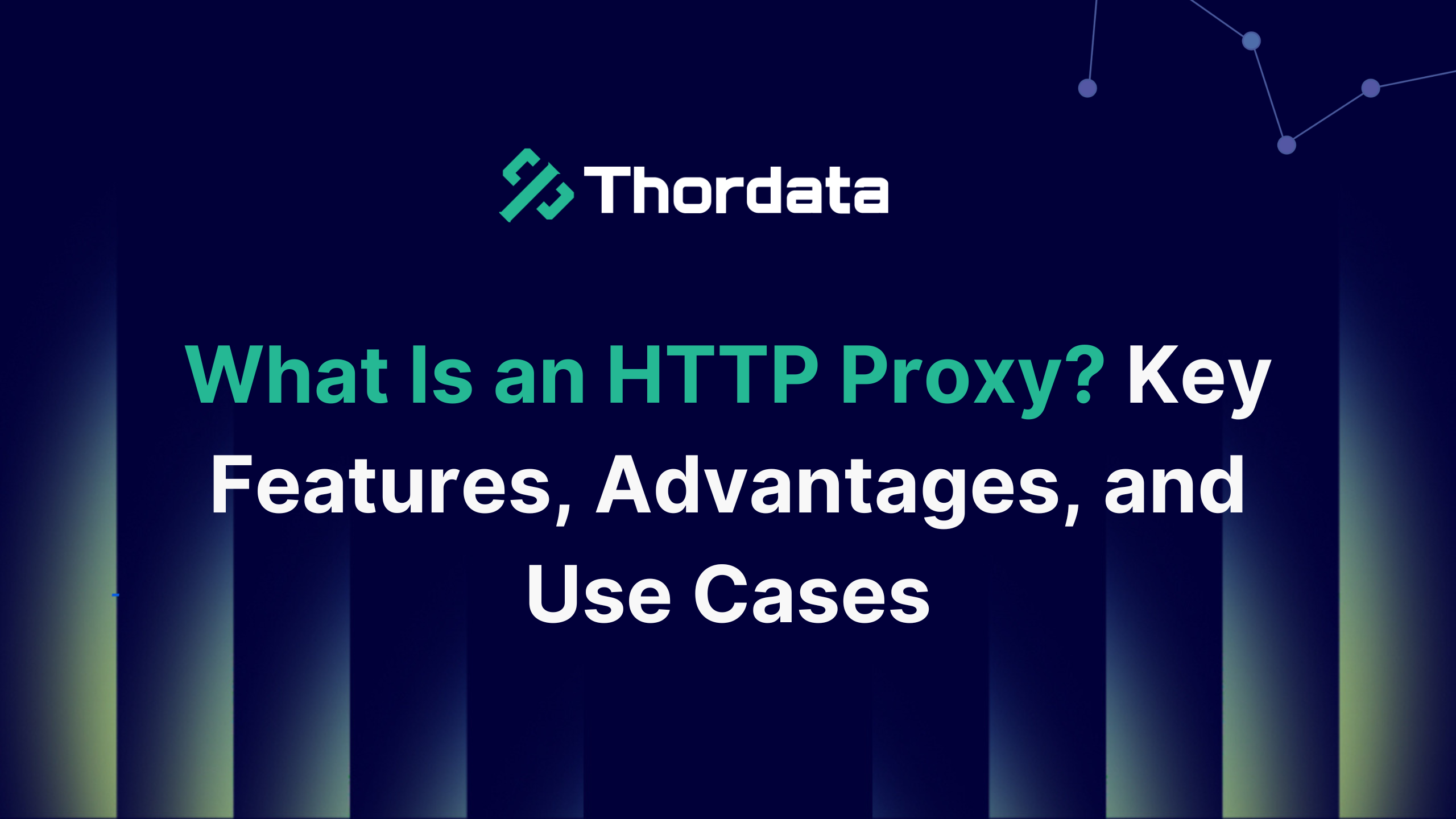

Most users don’t realize how HTTP proxies constantly work behind the scenes. These specialized servers significantly boost bandwidth efficiency through smart caching mechanisms – storing copies of frequently accessed content locally so it loads faster while simultaneously reducing the load on destination servers. But what exactly is an HTTP proxy?
This guide walks you through everything essential about HTTP proxies – starting with core concepts and moving to practical applications.
What is an HTTP Proxy?
HTTP proxy servers work as mediators between your device and web servers on the internet. This digital middleman processes web requests and creates a buffer that gives many advantages to people and organizations.
Definition and basic concept
HTTP proxy servers handle all communication between clients (like your web browser) and web servers that host content you want to see. Your browser creates data packets when you type a web address and hit Enter. These packets reach the HTTP proxy first instead of going straight to the destination server. The proxy adds its own IP address to the data packets and sends them to the target website for you.
HTTP proxies do more than simple routers or gateways. They work at the application layer (Layer 7) of the networking model and can see what’s inside requests and responses. This key difference lets them check, filter, change, or record these interactions. That’s why they’re such versatile tools for network management.
HTTP vs HTTPS proxy
HTTP and HTTPS proxies differ mainly in how they keep data safe. Regular HTTP proxies deal with unencrypted HTTP traffic – the simple communication protocol that runs much of the web. The lack of encryption means HTTP proxies don’t have built-in security.
HTTPS proxies handle HTTPS traffic, where ‘S’ means ‘Secure’. They work differently from HTTP proxies because they use encrypted communications. HTTPS proxies create a TCP connection for end-to-end encryption instead of just passing requests through. This makes them much safer for sending sensitive information.
Remember that HTTP proxies can handle HTTPS traffic but don’t add any security or encryption. You should use HTTPS proxies when dealing with sensitive data.
How Does an HTTP Proxy Work?
A click on your screen sets off a complex chain of events through an HTTP proxy in milliseconds. The way data moves across the internet changes completely with these behind-the-scenes operations that do much more than just route data.
Step-by-step request flow
Your web request follows a specific path through an HTTP proxy:
1.Original request: Your device sends a web request to the HTTP proxy server before it reaches its final destination.
2.DNS resolution: The proxy looks up the actual IP address of the website you want to visit.
3.Connection establishment: The proxy creates a connection to the destination server for you.
4.Request forwarding: The proxy puts its own IP address on your data packets and sends them to the website.
5.Server response: The destination server sends its response to the proxy instead of you.
6.Response delivery: The proxy sends the content back to your device.
The whole ordeal happens so fast that you barely notice the proxy at work. Each step plays a vital role in how the proxy operates.
Role of proxy in client-server communication
HTTP proxies change how clients and servers talk to each other. They sit in the middle to receive client requests, process them based on rules, and send them to the right servers. This position lets them do several important things.
The proxy can check and change the content of requests and responses in standard HTTP connections because it works at the application layer. It also helps with HTTPS traffic by using the CONNECT method to create a TCP tunnel between client and server.
Mozilla’s documentation shows that the HTTP CONNECT method “asks a proxy to create an HTTP tunnel to a server, and if successful, it moves data both ways until the tunnel closes”. This creates a secure connection where the proxy just acts as a tunnel.
HTTP proxies can control access based on rules, user credentials, or IP addresses. They also hide your real IP address, which makes it hard for websites to find your location.
Caching and compression explained
HTTP proxies boost network performance through caching and compression.
Caching lets proxies keep copies of popular web content locally. The proxy checks if it has a recent valid copy before sending requests to servers. Users get this cached version right away, which saves bandwidth and makes pages load faster. Apache Traffic Server states that “HTTP proxy caching lets you store copies of common web objects and serve them to users quickly”.
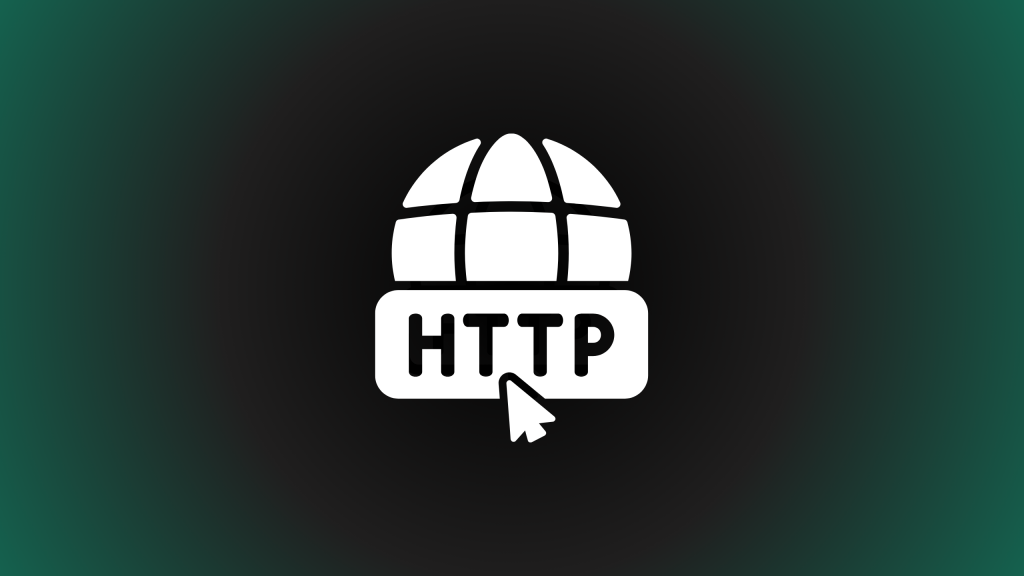
Types of HTTP Proxies
HTTP proxies come in several different types. Each type serves specific purposes and security needs in network infrastructures. The right proxy choice depends on your particular needs.
Forward proxy
Forward proxies work between users and the internet. Your browser sends requests to the proxy server first. The server then forwards these requests to destination websites. This process hides your identity by replacing your IP address with the proxy’s address in outgoing requests.
Reverse proxy
Unlike forward proxies that help clients, reverse proxies work on the server side. They catch requests meant for your servers and route them properly while keeping the actual server setup hidden from outside users.
Reverse proxies are great for:
1.Load balancing – They spread incoming traffic among multiple backend servers to prevent overload
2.Security improvement – These proxies create an extra layer of protection by hiding backend servers
3.Content acceleration – Storing static content, compression, and SSL termination help websites run faster
4.Application firewall capabilities – Many reverse proxies protect against common threats like DDoS attacks
Transparent proxy
Transparent proxies work quietly in the background without users knowing about them. They process and filter traffic but don’t change request headers or hide users’ original IP addresses.
These proxies show their IP in the “Via” header while keeping the user’s IP in the “X-Forwarded-For” header. Organizations use transparent proxies to:
1.User authentication – Make users log in on public WiFi networks
2.Content filtering – Stop access to inappropriate sites in schools or offices
3.Network activity monitoring – Keep track of bandwidth use and web browsing patterns
4.Caching frequently visited websites – Speed up access and save bandwidth
High anonymity proxy
High anonymity proxies (elite proxies) give the best privacy protection. They hide all signs that someone is using a proxy, unlike transparent or regular anonymous proxies.
These advanced proxies remove all headers that might show proxy use, including “Via,” “X-Forwarded-For,” and “Proxy-Authorization.” Users who want complete privacy get:
1.Complete IP masking – No traces of the original IP address remain
2.Proxy detection prevention – Websites can’t tell that someone’s using a proxy
3.Highest level of privacy – Connections appear to come straight from the proxy server
4.Bypassing advanced blocking systems – Users can get around sophisticated proxy detection
Benefits of Using HTTP Proxies
HTTP proxy servers give you and your organization many advantages to improve your online experience. These systems act as middlemen between you and the internet. They help with security and make everything work faster.
Improved security and threat filtering
HTTP proxies create a strong defense by checking all traffic before it reaches users. They spot and stop harmful content, malware, and phishing attacks by looking at data packets going in and out. These proxies work just like firewalls. They block connections to dangerous websites and scan downloads before they enter your network. Your cybersecurity gets better because there’s an extra layer of protection between users and threats. The proxies can encrypt your data too, which makes it harder for attackers to steal your sensitive information.
Faster content delivery and caching
HTTP proxies really shine when they save frequently visited content locally. This smart caching cuts down on repeated requests to source servers. Your network uses less bandwidth and pages load faster. Most companies set up proxy servers to watch and store popular website data. This means you don’t need to fetch the same information from the internet every time. These proxies also use compression to shrink data size. You get smooth browsing even with limited bandwidth.
Content filtering and access control
Companies often use HTTP proxy servers to enforce their internet usage rules. They can block websites like social media or streaming services to keep employees focused. Schools do this too – they stop access to inappropriate content. You can set different rules for different groups. Access can change based on who’s using it, what time it is, or where they’re connecting from.
Traffic monitoring and analytics
HTTP proxies let you watch network traffic from one central point. Network admins learn about user behavior, bandwidth use, and possible security threats. Detailed logs help spot unusual activities that might mean someone broke in or broke the rules. The monitoring tools catch large file uploads or strange access patterns that could mean data theft. These tools help keep networks safe and resources properly allocated based on real usage.
Common Use Cases for HTTP Proxies
Organizations and people in all sectors use HTTP proxies to solve specific technical challenges. These versatile tools have grown beyond simple intermediaries and become vital parts of modern network infrastructure.
Enterprise network management
Companies rely on HTTP proxy servers to control their employees’ internet access. They can block websites that don’t meet organizational standards and show messages like “This website is not permitted” when someone tries to access restricted content. HTTP proxies help detect suspicious traffic and protect web servers from external cyberattacks. These tools let multiple users access the same connection, which makes them valuable for big organizations that need centralized internet management.
Content delivery networks (CDNs)
CDNs stand out as one of the most common uses of HTTP proxy technology today. These networks of proxy servers spread across different locations cache content close to users and cut down latency. CDNs deliver content fast by placing servers at internet exchange points. The speed boost isn’t the only benefit—companies can reduce their bandwidth costs by 40-80% based on how much content they can cache. On top of that, CDNs boost reliability through load balancing and guard against distributed denial-of-service (DDoS) attacks.
Web scraping and automation
HTTP proxies provide the backbone for large-scale data collection. Web scraping tools need proxies to switch between IP addresses, which helps them avoid detection and blocking by target websites. Data collection would hit rate limits and IP bans almost right away without this feature. Professional web scraping operations stay away from risky public proxies and instead use dedicated or shared proxy pools with smart rotation strategies.
Anonymity networks and censorship bypass
HTTP proxies are crucial for systems that help people get around internet censorship worldwide. Users can access blocked websites by sending traffic through servers outside censored areas. Some clever systems create many short-lived browser-based proxies that let censored users jump between them as they pop up and disappear. These temporary proxies handle even video streaming while making it hard for censors to block them.
Load balancing and scalability
HTTP proxies shine at spreading network traffic across multiple backend servers. This load balancing stops single servers from getting overloaded and improves system reliability. Proxies route requests smartly using different algorithms (round-robin, least connections, IP hash) based on each server’s health and capacity. This setup lets organizations add more servers to handle growing traffic without disruption.
Conclusion
The versatility of HTTP proxy technology stays relevant as internet architecture changes. These systems adapt to meet challenges in a variety of sectors, whether you use them for content delivery networks, web scraping, or bypassing censorship.
Thordata’s HTTPS proxies combine high-strength encryption technology with intelligent traffic management, providing enterprise-level security while ensuring efficient and stable network access. Compared to traditional proxies, Thordata not only enhances the confidentiality and integrity of data during transmission but also supports precise access control and anonymity protection, making it suitable for users and organizations that need to maintain high-speed connections while ensuring privacy.
Frequently asked questions
What is an HTTP proxy and why is it important?
An HTTP proxy is a server that acts as an intermediary between users and the internet. It’s important because it enhances security, improves performance through caching, provides anonymity, and allows for content filtering and access control.
How does an HTTP proxy differ from an HTTPS proxy?
An HTTP proxy handles unencrypted traffic, while an HTTPS proxy is designed for encrypted communications. HTTPS proxies provide an additional layer of security, making them more suitable for transmitting sensitive information.
What is http proxy iphone?
An HTTP proxy on an iPhone is a server that acts as an intermediary between your iPhone and the internet. When you configure an HTTP proxy on your iPhone, your web traffic (specifically HTTP and sometimes HTTPS) is routed through that proxy server.
About the author
Yulia is a dynamic content manager with extensive experience in social media, project management, and SEO content marketing. She is passionate about exploring new trends in technology and cybersecurity, especially in data privacy and encryption. In her free time, she enjoys relaxing with yoga and trying new dishes.
The thordata Blog offers all its content in its original form and solely for informational intent. We do not offer any guarantees regarding the information found on the thordata Blog or any external sites that it may direct you to. It is essential that you seek legal counsel and thoroughly examine the specific terms of service of any website before engaging in any scraping endeavors, or obtain a scraping permit if required.